Karl Shuker's Blog, page 35
September 3, 2015
CRYPTO-SELFIES! IN THE PICTURE WITH SOME SERIOUSLY WEIRD – BUT WONDERFUL – WILDLIFE
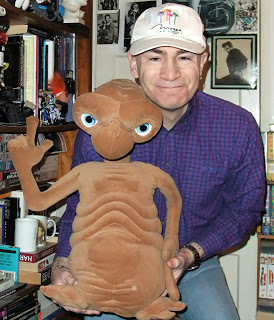 With E.T. – how could I not take pity on this errant extraterrestrial and bring him back home with me? In any case, he must be happy here – he hasn't phoned home once, which is just as well, bearing in mind the cost of intergalactic telephone calls these days! (© Dr Karl Shuker)
With E.T. – how could I not take pity on this errant extraterrestrial and bring him back home with me? In any case, he must be happy here – he hasn't phoned home once, which is just as well, bearing in mind the cost of intergalactic telephone calls these days! (© Dr Karl Shuker)Over the years, I've found myself sharing space in photographs – selfies, as they'd be called nowadays – with some exceedingly strange entities (and those are just my friends!). But seriously, browsing through my albums recently I came upon a considerable number featuring me alongside some truly weird – but indisputably wonderful – wildlife. So here, as one of my more light-hearted ShukerNature contributions, and the first of an occasional series, is a dozen of my most memorable crypto-selfies, annotated with a bountiful abundance of decidedly (ir)relevant information…
 Alongside a black cheetah statue at Colchester Zoo, in Essex, England, which I visited in 2013; as noted in my books
Mystery Cats of the World
and
Cats of Magic, Mythology, and Mystery
, a few records of all-black (melanistic) cheetahs are indeed on file, including a specimen spied in the company of a normal cheetah by Lesley D.E.F. Vesey-Fitzgerald in Zambia during the first half of the 20thCentury, and another one sighted in Kenya's Trans-Nzoia District by H.F. Stoneham in 1925 (© Dr Karl Shuker)
Alongside a black cheetah statue at Colchester Zoo, in Essex, England, which I visited in 2013; as noted in my books
Mystery Cats of the World
and
Cats of Magic, Mythology, and Mystery
, a few records of all-black (melanistic) cheetahs are indeed on file, including a specimen spied in the company of a normal cheetah by Lesley D.E.F. Vesey-Fitzgerald in Zambia during the first half of the 20thCentury, and another one sighted in Kenya's Trans-Nzoia District by H.F. Stoneham in 1925 (© Dr Karl Shuker)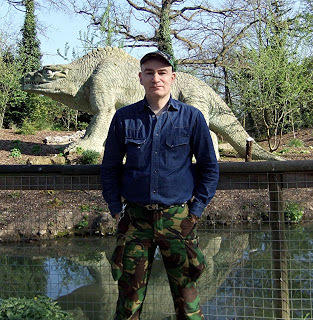 With one of the famous 19th-Century dinosaur statues at Crystal Palace Park in Bromley, London, which I visited in 2009; created by famous sculptor Benjamin Waterhouse Hawkins (1807-1894) and totally outdated now, this one is meant to be a Megalosaurus, but its reconstruction was guided by the popular yet erroneous belief current at that time that dinosaurs resembled giant lizards (© Dr Karl Shuker)
With one of the famous 19th-Century dinosaur statues at Crystal Palace Park in Bromley, London, which I visited in 2009; created by famous sculptor Benjamin Waterhouse Hawkins (1807-1894) and totally outdated now, this one is meant to be a Megalosaurus, but its reconstruction was guided by the popular yet erroneous belief current at that time that dinosaurs resembled giant lizards (© Dr Karl Shuker)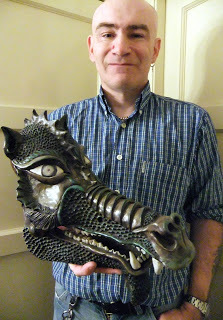 Holding a Brazilian were-pig skull – hailing from Rio de Janeiro, this is the skull of a wild boar that has been intricately decorated to resemble the supposed appearance of a Brazilian were-pig's head (© Dr Karl Shuker)
Holding a Brazilian were-pig skull – hailing from Rio de Janeiro, this is the skull of a wild boar that has been intricately decorated to resemble the supposed appearance of a Brazilian were-pig's head (© Dr Karl Shuker)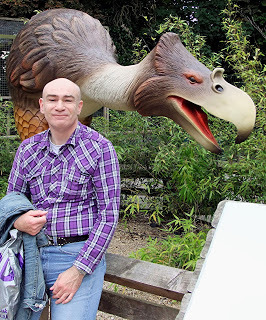 At Drayton Manor Park and Zoo, in Staffordshire, England, standing somewhat warily alongside a disconcertingly life-like, life-sized replica of North America's late Pliocene/early Pleistocene terror bird Titanis walleri, which may have stood up to 8 ft tall – check out my book
The Menagerie of Marvels
for an extensive chapter documenting the history of these flightless but fleet-footed and sometimes truly gargantuan carnivorous birds (© Dr Karl Shuker)
At Drayton Manor Park and Zoo, in Staffordshire, England, standing somewhat warily alongside a disconcertingly life-like, life-sized replica of North America's late Pliocene/early Pleistocene terror bird Titanis walleri, which may have stood up to 8 ft tall – check out my book
The Menagerie of Marvels
for an extensive chapter documenting the history of these flightless but fleet-footed and sometimes truly gargantuan carnivorous birds (© Dr Karl Shuker)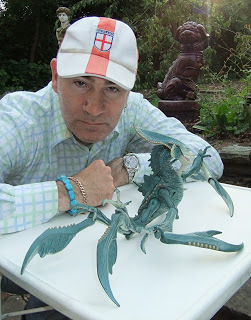 With an acklay – when I purchased this model at a market a few years ago, I had no idea what the creature was that it represented, but thanks to some knowledgeable sci-fi enthusiast friends on Facebook I soon learnt that it was an acklay, a huge non-sentient carnivore up to 11.5 ft tall, hailing from the planet Vendaxa in the Star Wars canon's universe (© Dr Karl Shuker)
With an acklay – when I purchased this model at a market a few years ago, I had no idea what the creature was that it represented, but thanks to some knowledgeable sci-fi enthusiast friends on Facebook I soon learnt that it was an acklay, a huge non-sentient carnivore up to 11.5 ft tall, hailing from the planet Vendaxa in the Star Wars canon's universe (© Dr Karl Shuker)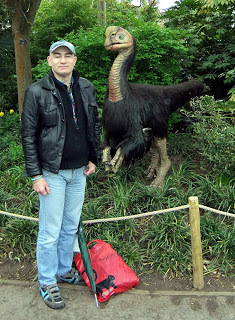 Alongside a life-sized animatronic model of the feathered dinosaur Citipati at Bristol Zoo, England, in 2013; an oviraptorid theropod from Mongolia's Late Cretaceous period, Citipatiwas named after a pair of murdered meditating monks from Tibetan Buddhist folklore, it possessed a large toothless beak, and it stood as large as a present-day emu; in this particular reconstruction, it looks decidedly cassowary-like (© Dr Karl Shuker)
Alongside a life-sized animatronic model of the feathered dinosaur Citipati at Bristol Zoo, England, in 2013; an oviraptorid theropod from Mongolia's Late Cretaceous period, Citipatiwas named after a pair of murdered meditating monks from Tibetan Buddhist folklore, it possessed a large toothless beak, and it stood as large as a present-day emu; in this particular reconstruction, it looks decidedly cassowary-like (© Dr Karl Shuker)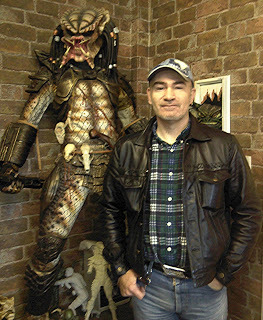 There I was, minding my own business walking round the small West Midlands, England, town of Cradley Heath, when, happening to step inside a sci-fi/comic shop, who should I encounter there but the Predator! I can only assume that my trusty leather biker jacket helped to conceal me from its thermal imaging capability long enough for me to get this photo snapped of me alongside it; if you're wondering why the photo is a little blurry, it's because the (ex) person taking it for me suddenly realised that unlike me he wasn't wearing anything to cloak his thermal image – I won't tell you what happened to him next, as I don't want to give you nightmares – suffice it to say that at least it kept the Predator occupied long enough for me to make my excuses and exit stage right! (© Dr Karl Shuker)
There I was, minding my own business walking round the small West Midlands, England, town of Cradley Heath, when, happening to step inside a sci-fi/comic shop, who should I encounter there but the Predator! I can only assume that my trusty leather biker jacket helped to conceal me from its thermal imaging capability long enough for me to get this photo snapped of me alongside it; if you're wondering why the photo is a little blurry, it's because the (ex) person taking it for me suddenly realised that unlike me he wasn't wearing anything to cloak his thermal image – I won't tell you what happened to him next, as I don't want to give you nightmares – suffice it to say that at least it kept the Predator occupied long enough for me to make my excuses and exit stage right! (© Dr Karl Shuker)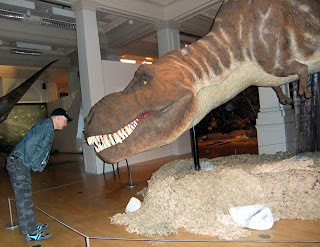 Face to face with a life-sized Tyrannosaurus rex model at a dedicated T. rex exhibition held at Birmingham Museum & Art Gallery in the West Midlands, England, during 2010 – it's not often that you get the chance to stare down a T. rex, although in this particular instance the only thing that I seemed to be staring down was its nostrils; Jurassic Park claimed that as long as you stood perfectly still, a T. rexwould be unable to detect you, so what better time to put this claim to the test?? © Dr Karl Shuker)
Face to face with a life-sized Tyrannosaurus rex model at a dedicated T. rex exhibition held at Birmingham Museum & Art Gallery in the West Midlands, England, during 2010 – it's not often that you get the chance to stare down a T. rex, although in this particular instance the only thing that I seemed to be staring down was its nostrils; Jurassic Park claimed that as long as you stood perfectly still, a T. rexwould be unable to detect you, so what better time to put this claim to the test?? © Dr Karl Shuker) 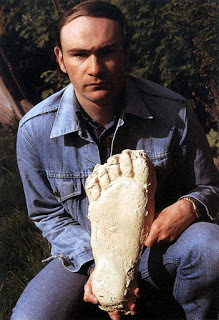 Holding a cast of a 16-inch-long bigfoot (sasquatch) footprint discovered at Grays Harbor, in Washington State, USA, during 1982; I purchased this particular cast from veteran bigfoot researcher Prof. Grover Krantz during the early 1990s (© Dr Karl Shuker)
Holding a cast of a 16-inch-long bigfoot (sasquatch) footprint discovered at Grays Harbor, in Washington State, USA, during 1982; I purchased this particular cast from veteran bigfoot researcher Prof. Grover Krantz during the early 1990s (© Dr Karl Shuker)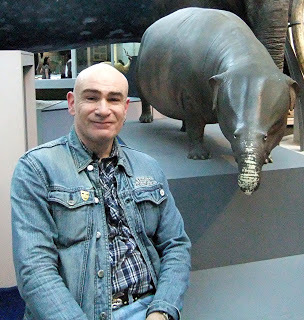 Sharing some quality time with a life-sized Moeritherium statue at London's Natural History Museum in 2014; this was a very early genus of proboscidean living during the Eocene epoch 37-35 million years ago in northern and western Africa, but dying out without giving rise to any modern-day elephant lineage; initially I was very puzzled that this statue's trunk seemed to have been rubbed so vigorously that much of its surface had lost its colour – why would this have happened? Then Facebook friend Adam Naworal reminded me that it was traditional to rub elephant statues for good luck, so that may well explain the otherwise anomalous case of the mutilated Moeritherium; fortunately, however, this doesn't seem to have traumatised him, as he seemed happy enough to be with me (© Dr Karl Shuker)
Sharing some quality time with a life-sized Moeritherium statue at London's Natural History Museum in 2014; this was a very early genus of proboscidean living during the Eocene epoch 37-35 million years ago in northern and western Africa, but dying out without giving rise to any modern-day elephant lineage; initially I was very puzzled that this statue's trunk seemed to have been rubbed so vigorously that much of its surface had lost its colour – why would this have happened? Then Facebook friend Adam Naworal reminded me that it was traditional to rub elephant statues for good luck, so that may well explain the otherwise anomalous case of the mutilated Moeritherium; fortunately, however, this doesn't seem to have traumatised him, as he seemed happy enough to be with me (© Dr Karl Shuker) Alongside Singapore's iconic merlion fountain-statue in 2005; the merlion is a legendary lion-headed fish known worldwide as a symbol of Singapore, and it is epitomised by this magnificent 28-ft-tall statue created by sculptor Lim Nang Seng during 1971-1972, and relocated in 2002 to a promontory in Singapore's Merlion Park(© Dr Karl Shuker)
Alongside Singapore's iconic merlion fountain-statue in 2005; the merlion is a legendary lion-headed fish known worldwide as a symbol of Singapore, and it is epitomised by this magnificent 28-ft-tall statue created by sculptor Lim Nang Seng during 1971-1972, and relocated in 2002 to a promontory in Singapore's Merlion Park(© Dr Karl Shuker)I hope that you've enjoyed this inaugural meander through my collection of crypto-selfies. Look out for further selections in future ShukerNature posts!

Published on September 03, 2015 21:02
August 31, 2015
PRESENTING THE TSMOK STATUE AT LAKE LEPEL IN BELARUS - AN AQUATIC DRAGON, A FLIPPERED WATER-DEER, OR A LONG-NECKED SEAL?
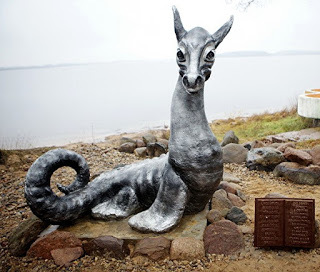 Lepel Tsmok, the tsmok statue, immediately after its ceremonial unveiling at Lake Lepel in Belarus on 9 November 2013 (© Alexander "Tarantino" Zhdanovich /
cmok.budzma.org/node/81
on
http://labadzenka.by/?p=25052
)
Lepel Tsmok, the tsmok statue, immediately after its ceremonial unveiling at Lake Lepel in Belarus on 9 November 2013 (© Alexander "Tarantino" Zhdanovich /
cmok.budzma.org/node/81
on
http://labadzenka.by/?p=25052
)Earlier this month, on 8 August 2015, the city of Lepel in Belarus's Vitebsk Province hosted an international festival of mythology entitled 'On a Visit to Lepel Tsmok' (click here to access its full programme of events). Among the varied array of subjects featured in this festival's talks and presentations was Lepel's very own legendary monster, one that was once virtually unknown to the outside world. Thanks to a wonderful statue here, however, all that is now changing, rapidly. But, as they say, to begin at the beginning…
 Publicity poster for Lepel's international festival of mythology, depicting Lepel Tsmok (© 'On a Visit to Lepel Tsmok' international festival)
Publicity poster for Lepel's international festival of mythology, depicting Lepel Tsmok (© 'On a Visit to Lepel Tsmok' international festival)On 14 September 2013, Lepel celebrated its 574thbirthday – and as part of those celebrations, a specially-commissioned statue was officially installed on the shores of Lake Lepel, a large body of freshwater that has always been a popular sight and attraction among visitors and locals alike here, and bordered today by Tract Tsmok, the city's park. Now, however, it is even more special, thanks to this remarkable, unique statue – which, following its ceremonial unveiling on 9 November 2013, swiftly become a veritable magnet for photo opportunities, its success in attracting tourists eager to see it and be photographed alongside it exceeding even the already high expectations held by the city's ruling council when originally sanctioning its creation.
For not only is the Lake Lepel statue both spectacular and highly photogenic, but in addition its subject is certainly no ordinary one. What it portrays is a tsmok – a legendary medieval water dragon of a type scarcely known outside Belarus and Lithuania (until 1793, Lepel was part of Lithuania, lying directly to the west of Belarus), but a few of which are said still to inhabit this lake's mysterious depths, at least according to traditional Lepel lore.
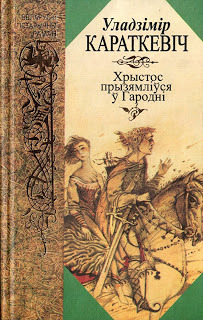 Vladzimir Karatkievich's novel Hrystos Pryzyamlіўsya ¢ Garodnі: Evangelle Іudy Hell ('Christ Has Landed in Grodno: The Gospel of Judas'), published in 1990 (© Vladimir Karatkevich)
Vladzimir Karatkievich's novel Hrystos Pryzyamlіўsya ¢ Garodnі: Evangelle Іudy Hell ('Christ Has Landed in Grodno: The Gospel of Judas'), published in 1990 (© Vladimir Karatkevich)The idea for the statue, which has been formally dubbed Lepel Tsmok, came from ethnographer Vladimir Shushkevich – aka 'Valatsuga' (Valadar) – whose home city is Lepel, where he has lived for many years, and who has a longstanding interest in the mythology of its fabled water beasts. Fellow Belarusian ethnographer Nikolai Nikiforovsky has also written about tsmoks, and they were mentioned by Slavic culture researcher Alexander Afanasyev too. In particular, however, Shushkevich is well-acquainted with esteemed Belarusian author Vladzimir Karatkievich's historical novel Hrystos Pryzyamlіўsya ¢ Garodnі: Evangelle Іudy Hell ('Christ Has Landed in Grodno: The Gospel of Judas'), published in 1990, which in its first section, 'The Fall of the Fiery Serpent', draws upon Lepel folklore chronicling how 40 tsmok were allegedly killed overnight in Lake Lepel during the Middle Ages. It also describes their morphological appearance, referring to them as behemoths with the head of a deer or snake and the body of a seal.
After Shushkevich conceived and publicised at various cultural and tourist festivals his proposed project of producing this tsmok statue, it was formally approved by an international jury from the European Union, along with nine other initiatives, all of which focused upon promoting sustainable rural tourism in Russia and Belarus. However, it was Shushkevich's statue project that received the largest EU grant – 2900 euros.
 Leo Oganov and Vladimir Shushkevich, with Oganov's plasticine scale model of his tsmok statue (© Lepel.by)
Leo Oganov and Vladimir Shushkevich, with Oganov's plasticine scale model of his tsmok statue (© Lepel.by)The sculptor selected by the Arts Council in the Regional Executive Committee to produce Lepel Tsmok was Leo Oganov (sometimes spelt Aganov) from Minsk, Belarus's capital, who had already received plaudits for a sculpture honouring a Grand Duchy of Lithuania leader that he had presented to Lepel in 2010, and which stands in the city's main square. (There is also a mermaid statue in Lepel, produced by Igor Golubev a year earlier.) Oganov prepared plasticine scale models of several different reconstructions of the tsmok, one of which resembled a typical fire-breathing, winged, non-aquatic dragon, but after much debate the eventual choice was very different, much more interesting, and extremely eyecatching.
The material that Oganov's Lepel Tsmok would be made from also became an important subject for debate. It was felt that bronze would prove too expensive, but other, more viable options included cast iron or silumin (a silicon-aluminium alloy). Cast iron was the final choice, bestowing upon it a silvery sheen reminiscent of shining fish scales, an appropriate look for an aquatic creature. When the statue was complete, it weighed just over 1 ton, and was 5.5 ft tall.
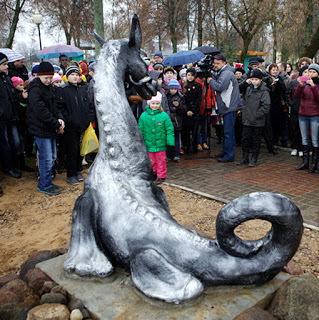 Rear view of Lepel Tsmok, showing its dorsal ridge (© Alexander "Tarantino" Zhdanovich / cmok.budzma.org/node/81 on http://labadzenka.by/?p=25052)
Rear view of Lepel Tsmok, showing its dorsal ridge (© Alexander "Tarantino" Zhdanovich / cmok.budzma.org/node/81 on http://labadzenka.by/?p=25052)Oganov drew inspiration for Lepel Tsmok's morphology from traditional, folkloric descriptions of this water monster, including those contained in Karatkievich's above-cited novel, but certain potentially fragile and therefore breakable features present in his original model of it needed to be amended or omitted entirely, in order to avoid the risk of subsequent damage to the statue once installed. These included a 'moustache' of catfish-like barbels around its mouth (omitted), a crest upon its head (reduced to a bare minimum), and a mane upon its neck (omitted). It was also made more people-friendly than the original tsmok dragons of lore (as well as less expensive to produce) by excluding wings, plus any suggestion of fire-breathing, human-devouring, and general offensiveness, but adding an amiable, friendly expression to its face.
The result is one of the most distinctive cryptid/legendary monster representations that I have ever seen (albeit only online so far). Overall, Lepel Tsmok resembles a fascinating composite of aquatic dragon, female (antler-lacking) water-deer, and long-necked seal. For whereas the long curling scaly tail is definitely dragonesque, its face and large ears are decidedly cervine (or even equine if its mane had been retained), but its overall body shape and flippers instantly recall those of a seal, particularly a long-necked one (as documented in detail by me here and here on ShukerNature).
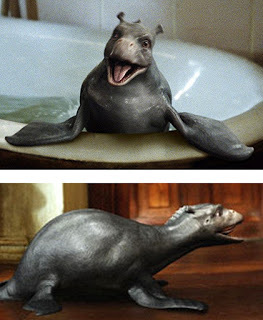 Two stills from the 2007 movie The Water Horse: Legend of the Deep, showing this cryptid in its small, juvenile stage (© Columbia Pictures)
Two stills from the 2007 movie The Water Horse: Legend of the Deep, showing this cryptid in its small, juvenile stage (© Columbia Pictures)It also reminds me a little of the juvenile stage of the eponymous cryptid in the wonderful 2007 fantasy movie The Water Horse: Legend of the Deep, which was based upon British author Dick King-Smith's children's novel The Water Horse (1990).
But just to confirm that Oganov's silvery tsmok is indeed true if not to life than at least to lore, placed alongside its statue in its installed form as an incorporated part of the complete sculpture is a representation in cast iron of an open book, upon whose pages is carved a written description of the tsmok's appearance as excerpted directly from Karatkievich's novel.
 Publicity poster for the 2007 movie The Water Horse: Legend of the Deep (© Columbia Pictures)
Publicity poster for the 2007 movie The Water Horse: Legend of the Deep (© Columbia Pictures)Today, almost two years on from its ceremonial unveiling, Oganov's Lepel Tsmok is inordinately popular, a veritable Nessie of the East has been born, with souvenirs and other likenesses of it sold nearby, and photos of visitors posing alongside it contained in numerous holiday albums and shared countless times online in social networking sites.
It is especially favoured by visitors about to be wed or newly-wed, however, because according to Lepel legend yet again, if offerings of food and drink from a wedding feast are brought to a tsmok's watery abode and left there, for it to consume at its leisure, the monster will bless the marriage and bestow good fortune upon the bride and groom. Today, such tributes are not normally brought to the tsmok statue, but newly-weds nonetheless derive great joy from posing alongside it, if only on the off-chance that doing so will in itself be sufficient for the magical, elusive creature that it portrays to look upon their union benevolently and grant them future happiness together.
From an obscure provincial monster of (very) local fable and fame, the tsmok seems set to acquire international celebrity status before much longer. And when it does, remember that, at least in English, you read it here first!
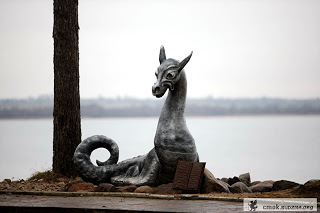 Leo Oganov's Lepel Tsmok (© Alexander "Tarantino" Zhdanovich /
cmok.budzma.org/node/81
on
http://labadzenka.by/?p=25052
)
Leo Oganov's Lepel Tsmok (© Alexander "Tarantino" Zhdanovich /
cmok.budzma.org/node/81
on
http://labadzenka.by/?p=25052
)Finally: Poland's traditional folklore contains a dragon-related tale that features the similar-sounding Smok. This was the dragon of Wawel Hill in Krakow, Poland, which had terrorised the city until Skuba, a canny cobbler's apprentice, stuffed a baited lamb with sulphur. After eating it, Smok was consumed with such a fiery thirst that he drank without pause from a nearby stream until finally the sulphur reacting with the vast quantity of imbibed water caused the doomed dragon to explode.
Incidentally, in 2011 a very large species of Polish carnivorous archosaurian reptile from the late Triassic Period 205-200 million years that may constitute a species of theropod dinosaur was officially christened Smok wawelski, in honour of this Polish dragon.
A souvenir ornament of Krakow's Smok, obtained from a friend several years ago (© Dr Karl Shuker)
Until my present ShukerNature blog article, virtually no information about the Belarusian tsmok existed in English, so I have relied very extensively upon translations of various Belarusian and Russian articles as my primary sources. Of these, a detailed online news article in Cyrillic script by Tatiana Matveeva, posted on 15 June 2013, was particularly beneficial to my researches – click here to access it directly.
And to read all about plenty of other unusual and unexpected dragon varieties from around the world, be sure to check out my recent book Dragons in Zoology, Cryptozoology, and Culture .
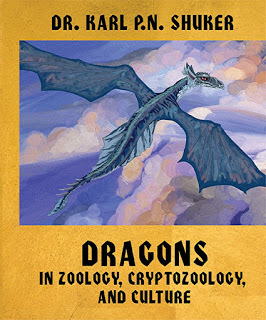
Published on August 31, 2015 15:47
August 30, 2015
MEDUSA'S MENAGERIE - NAME-CHECKING SOME ZOOLOGICAL GORGONS FROM THE PRESENT AND THE PAST
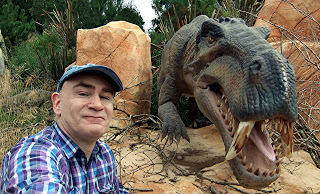 Photo-bombed by a gorgonopsid – it could only happen to me! © Dr Karl Shuker)
Photo-bombed by a gorgonopsid – it could only happen to me! © Dr Karl Shuker)Deriving their name from 'gorgos', an ancient Greek word translating as 'dreadful', the gorgons are undoubtedly among the most infamous, terrifying monsters in classical Greek mythology. A trio of nightmarish sisters born to the ancient sea deities Phorcys and Ceto, each of these three horrific entities was feared for the writhing, seething, sibilant mass of living venomous serpents that composed her hair, and even more so for her hideous visage's dreadful gaze, which was absolutely petrifying, literally – because anyone who looked directly into her face and eyes was instantly and irrevocably turned to stone.
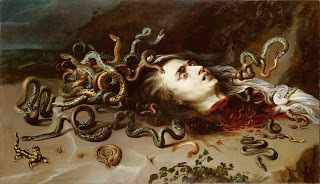 The decapitated head of Medusa, slain by Perseus, as painted by Peter Paul Rubens, c.1617-1618; intriguingly, note that among the snakes breaking free from her hair following her death is an amphisbaena (head at each end of its body) directly below her head, and a very strange-looking fox-headed serpent to the left of the amphisbaena (separating the two is a scorpion) - click to enlarge (public domain)
The decapitated head of Medusa, slain by Perseus, as painted by Peter Paul Rubens, c.1617-1618; intriguingly, note that among the snakes breaking free from her hair following her death is an amphisbaena (head at each end of its body) directly below her head, and a very strange-looking fox-headed serpent to the left of the amphisbaena (separating the two is a scorpion) - click to enlarge (public domain)Ironically, the two immortal gorgons, Stheno and Euryale, scarcely feature at all in Greek mythology and are therefore all but forgotten beyond the cloistered domain of classical scholars, even though one might have expected that their invulnerable, inviolate nature coupled with their lethal power of petrification would surely have set them in good stead indeed as truly daunting opponents for any of the famous Greek heroes to vanquish. However, it is commonly believed that their existence was a later addition to an original myth of just a single, mortal gorgon, because there are so many trinities of female monsters or other entities in Greek mythology (e.g. the Graeae or Grey Sisters, the Furies or Erinyes, the Horae, the Charites or Graces), so this may well explain, their virtual absence from classical legend.
(Interestingly, the premise of a 1964 British horror movie made by Hammer Films, starring Christopher Lee and Peter Cushing, and entitled The Gorgon was the survival into modern times of one of the two immortal gorgons; but the film's researchers apparently made a major error, because they named her as Megaera, who in Greek mythology wasn't a gorgon at all, but was instead one of the three Furies, together with Tisiphone – erroneously named in this same movie as the second immortal gorgon – and Alecto.)
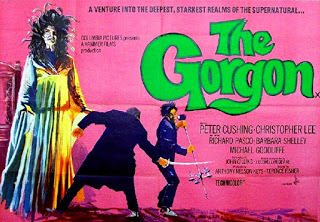 Poster advertising the 1964 Hammer Films horror movie The Gorgon (© Columbia Pictures/reproduced here on the basis of non-commercial fair use only)
Poster advertising the 1964 Hammer Films horror movie The Gorgon (© Columbia Pictures/reproduced here on the basis of non-commercial fair use only)Conversely, it is the third gorgon, that single mortal representative, who has seized virtually all of the public attention afforded to this terrifying trio. Her name? Medusa.
Medusa's horror-laden history has assumed many forms during the countless tellings and retellings by all manner of writers, chroniclers, and narrators down through the ages – even including variants in which she was originally a stunningly beautiful maiden but was transformed into a merciless, embittered monster with deadly gaze after finding disfavour with one or other of the Greek deities. Irrespective of her origin, however, Medusa was eventually slain by the demigod hero Perseus, who skilfully succeeded in slicing off her head with his sword while only looking at her indirectly, via a reflection in the highly-polished surface of his mirrored shield – a gift to him from his divine protector, the goddess Athena.
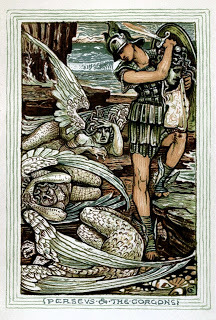 Perseus and the gorgons, with Perseus holding up the decapitated head of Medusa; illustrated by Walter Crane for Nathaniel Hawthorne's A Wonder-Book For Girls and Boys, 1893 edition (public domain)
Perseus and the gorgons, with Perseus holding up the decapitated head of Medusa; illustrated by Walter Crane for Nathaniel Hawthorne's A Wonder-Book For Girls and Boys, 1893 edition (public domain) Perseus was the very first of the classical Greek heroes, who went on to become the legendary founder of Mycenae. His father was the god Zeus, his mother Danaë, a daughter of King Acrisius of Argos and his wife Queen Eurydice, whom Zeus famously visited and impregnated in the guise of a shower of golden rain.
In later ages, carvings of Medusa's head were incorporated in a number of classical architectural features, such as columns, arches, door panels, decorative grilles, sarcophagi, fountains, statues, and mosaics, to ward off evil spirits, and the image was also a popular depiction on protective amulets. This visual device is known as a gorgoneion.
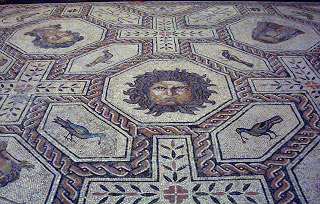 A gorgoneion entitled 'Medusa and the Seasons', in a Roman mosaic found at Palencia, Spain, and dated at 167-200 AD (© Luis Garcia/Wikipedia)
A gorgoneion entitled 'Medusa and the Seasons', in a Roman mosaic found at Palencia, Spain, and dated at 167-200 AD (© Luis Garcia/Wikipedia)Today, Stheno and Euryale remain largely unknown; but despite having been slain, Medusa still lives on, or at least her name and that of her monstrous kind do – which is due not only to the popularity of her memorable legend but also, in turn, because both 'gorgon' and 'Medusa' have been applied to a wide range of very remarkable, entirely real creatures, some living, others once-living. So permit me now to take you all on a brief, ShukerNature-led visit to the extraordinary menagerie of Medusa.
HOW AN AQUATIC GORGON-HEAD BECAME AN INTERNET ALIEN – OR WAS IT THE OTHER WAY ROUND?!
According to a report posted online during late September 2014 by Britain's Sunday Express newspaper and written by Levi Winchester, a 54-year-old Singapore fisherman named Ong Han Boon had recently captured in waters off the southern Singapore island of Sentosa a creature so bizarre in appearance that he seriously wondered whether it might be an alien, an extraterrestrial! Before releasing it back into the sea, he filmed a short video of it that duly appeared in the above-noted newspaper report (click here to view it there), and on 28 September a Singapore-based member of Facebook called Jr Saim publicly shared the video on his FB timeline (click here to view it on Facebook). The video swiftly went viral, soon appearing – and still appearing – on numerous news and video-sharing websites.
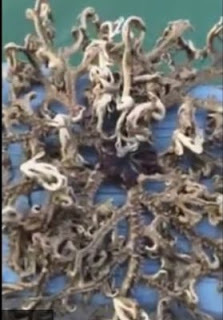 Still from the Singapore Gorgonocephalus video (© Ong Han Boon)
Still from the Singapore Gorgonocephalus video (© Ong Han Boon) But what was the creature that it showed? Those of an ophidiophobic disposition who have not already watched it might choose to avert their eyes from the video, because the entity in it looks disturbingly like a hideous matted wig composed of writhing, twisting, curling and uncurling serpentine tresses – a veritable Medusa scalp, in fact. And nomenclaturally, if not taxonomically, that is precisely what it is, because its scientific binomial name is Gorgonocephalus caputmedusae – 'gorgon-headed Medusa head'.
Happily, however, this grotesque entity lacks the petrifying power of its namesake, and it isn't of extraterrestrial origin either, because in reality it is nothing more startling than a sea-dwelling starfish, or, more specifically, a basket star. These particular invertebrates belong to a taxonomic class of echinoderms known as ophiuroids, whose most famous members are the notably long-limbed brittle stars.
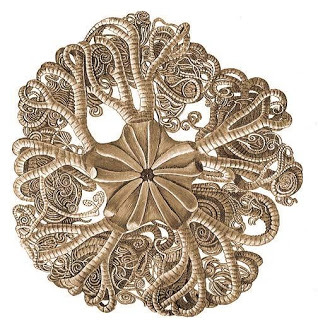 Gorgonocephalus arborescens
, from Alfred Edmund Brehm's famous multi-volume animal encyclopaedia Tierleben ('Animal Life'), which was originally published in 6 volumes during the 1860s and then republished as an expanded 10-volume second edition during the 1870s (public domain)
Gorgonocephalus arborescens
, from Alfred Edmund Brehm's famous multi-volume animal encyclopaedia Tierleben ('Animal Life'), which was originally published in 6 volumes during the 1860s and then republished as an expanded 10-volume second edition during the 1870s (public domain)In a Gorgonocephalus basket star, however, of which there are several species, each of the five arms radiating from its central disc repeatedly divides and subdivides, yielding the somewhat disturbing, wriggling mass of miniature snake-like 'armlets' so vividly captured in the above video, and whose serpentine resemblance is heightened by their fleshy covering of pink rubbery skin. For a much more appealing, stationary representation of a Gorgonocephalus basket star, here is German biologist and artist Prof. Ernst Haeckel's exquisite rendition:
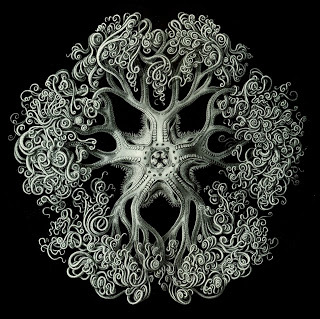 Gorgonocephalus
basket star, appearing in Prof. Ernst Haeckel's gorgeously-illustrated, 2-volume tome Kunstformen der Natur ('Art Forms in Nature'), published in 1904 (public domain)
Gorgonocephalus
basket star, appearing in Prof. Ernst Haeckel's gorgeously-illustrated, 2-volume tome Kunstformen der Natur ('Art Forms in Nature'), published in 1904 (public domain)And here's an illustration of a reddish-coloured species named after the famous 19th-Century American zoologist and geologist Prof. Louis Agassiz – Gorgonocephalus agassizi:
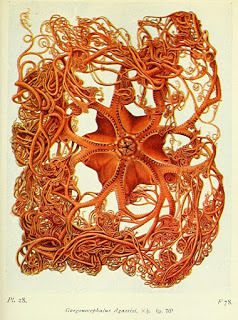 Gorgonocephalus agassizi
, 1800s rendition (public domain)
Gorgonocephalus agassizi
, 1800s rendition (public domain)When seeking prey, Gorgoncephalus takes up a stationary position and then spreads out its innumerable tiny armlets like a basket. Each of these small but highly dexterous armlets is equipped with hooks and spines to seize and hold prey, normally krill or other planktonic forms, which they then convey to the mouth on the underside of the animal's central disc with the added assistance of a series of suctioned tube-feet.
A GORGON-GUTTED RIBBON WORM
No less grotesque and slightly stomach-churning than the Gorgonocephalus video of 2014 was a more recent one, seemingly first aired in May 2015 but again swiftly going viral and appearing on numerous websites, but featuring, as it turned out, another gorgon-dubbed creature with equally discomforting behaviour. The video (whose original ownership is presently unknown to me) can be viewed here , and shows a long blood-red worm-like creature originating in the seas off Thailand but resting on someone's hand that suddenly releases from its mouth a long thick white tube from which an intricate mass of white filaments shoot forth and which momentarily writhe about before sticking to the person's hand – almost as if this mini-monster has disgorged a gorgon's head of serpentine hair! Nor is that my own peculiar impression – the same notion clearly occurred to others too, because the generic name of the vermiform creature in question is none other than Gorgonorhynchus. This roughly translates as 'gorgon-beaked', though the beak in this instance is actually a proboscis.
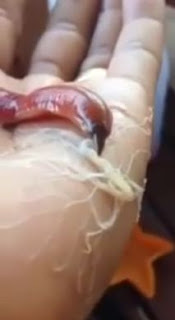 Still from the video of the Thai Gorgonorhynchus nemertean everting its proboscis on a person's hand (copyright owner currently unknown to me)
Still from the video of the Thai Gorgonorhynchus nemertean everting its proboscis on a person's hand (copyright owner currently unknown to me) As someone who studied such creatures during a university project, I was very familiar with this animal's behaviour, repulsive though it evidently seemed to many other viewers of the video, judging from various comments posted concerning it. The creature is a nemertean, or ribbon worm, Nemertea (aka Rhynchocoela) being a phylum of invertebrates whose members are characterised by their often very long slender bodies and in particular by their possession of a lengthy prey-capturing proboscis. This distinctive organ is normally held inside the worm's mouth within its own sheath (the rhynchocoel) and in an inverted, inside-out conformation, but when the worm encounters a potential prey victim, it is instantly and quite explosively shot out through the worm's mouth in everted form. The proboscis usually bears hooks at its tip that seize the prey, and sometimes inject it with venom too, after which the prey is swiftly hauled back inside the worm's body via the proboscis's immediate muscle-powered retraction through the mouth in inverted form once more.
 Illustration of Gorgonorhynchus reptens everting its branched proboscis after feeling threatened from being touched (© Rachel Koning/Wikipedia)
Illustration of Gorgonorhynchus reptens everting its branched proboscis after feeling threatened from being touched (© Rachel Koning/Wikipedia)In most nemerteans, the proboscis is a long, simple tube, but in certain species, including those of the genus Gorgonorhynchus, the tube possesses many branching sticky filaments that divide and subdivide in a manner analogous to the armlets of the basket star Gorgonocephalus, and which, again like the latter's armlets, wriggle and writhe as if they were a multitude of tiny snakes, before wrapping themselves around the prey, encapsulating it in an adhesive mass from which it cannot pull out, almost like the gossamer produced by a spider. In effect, therefore, when the nemertean everted its proboscis all over the person's hand, it was either stressed or feeling threatened from being handled or it was reacting as if the hand were prey, and hence was vainly attempting to wrap it up in its proboscis's sticky filaments.
GORGONS FROM PREHISTORY
Moving now from the present back to the (very) far-distant past: in the mid to late Permian Period (265 to 252 million years ago), when dinosaurs were still merely a future twinkle in the eye of evolution, a reptile-originating lineage existed whose members were so genuinely monstrous in form and size that in 1876 the great 19th-Century palaeontologist Prof. Sir Richard Owen fittingly named them after Greek mythology's own historical (albeit not prehistorical!) horrors, the gorgons. For he christened their type genus and species Gorgonops torvus, after which genus their entire taxonomic group (currently deemed a suborder) duly derived its name – Gorgonopsia – in 1895, as dubbed by British palaeontologist Prof. Harry G. Seeley.
Also called gorgonopsians, the gorgonopsids belong to the taxonomic order of synapsid reptiles known as Therapsida, whose members are often referred to colloquially as the mammal reptiles or mammal-like reptiles, and do indeed belong to the same taxonomic clade, Theriodontia, as do true mammals.
 A life-sized animatronic gorgonopsid on exhibition at the West Midlands Safari Park in England, August 2015 (© Dr Karl Shuker)
A life-sized animatronic gorgonopsid on exhibition at the West Midlands Safari Park in England, August 2015 (© Dr Karl Shuker)Gorgonopsids were among the largest of all carnivorous vertebrates alive at that time (the biggest, Inostrancevia from northern Russia, was up to 11.5 ft long, the size of a large bear or small rhinoceros, with the aptly-named Titanogorgan maximus from Tanzania only slightly smaller), and they were certainly the dominant ones. Even so, in genera such as Gorgonops itself, native to what is now Africa, their most memorable features were their enormous sabre-like canine teeth – so large that they almost projected below their lower jaw.
Gorgonopsids also had pillar-like legs that arose from underneath their bodies like those of mammals rather than splaying from their sides like reptiles. This important anatomical feature enabled them to move more swiftly and energy-efficiently than their lumbering herbivorous prey, which included some very large, hefty plant-eating reptiles known as pareiasaurs, some of which, like Scutosaurus, were armoured for protection.
 The gorgonopsid Inostrancevia alexandri attacking the pareiasaur Scutosaurus karpinski (© Dmitry Bogdanov/Wikipedia)
The gorgonopsid Inostrancevia alexandri attacking the pareiasaur Scutosaurus karpinski (© Dmitry Bogdanov/Wikipedia)The gorgonopsids perished entirely during the mass extinction at the end of the Permian, the only theriodont lineage to become extinct during that catastrophic event, but they were sensationally resurrected in CGI if not in life itself during the early 2000s by Britain's highly popular ITV sci-fi television show Primeval. In the very first episode, originally screened in Britain on 10 February 2007, a marauding gorgonopsid of the genus Gorgonopsequipped with a monstrously large pair of upper canines confidently stepped forth from out of the Permian and into the present day via a temporary gateway through time known as an anomaly, wreaking havoc in Gloucestershire's Forest of Dean, tenaciously stalking the perplexed scientists sent to deal with this ferocious anachronistic therapsid, and vibrantly demonstrating to enthralled viewers everywhere that carnivorous dinosaurs were not the only prehistoric predators that oozed charisma and exuded terror in equal proportions. Moreover, another Gorgonopsfeatured in the final episode of this first series of Primeval.
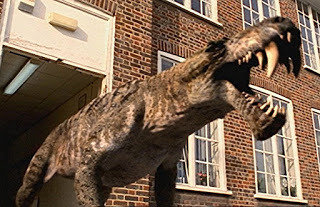 A gorgonopsid on the prowl in Episode 1, Series 1 of Primeval (© ITV Studios/ProSieben/Impossible Pictures/Treasure Entertainment/M6 Films)
A gorgonopsid on the prowl in Episode 1, Series 1 of Primeval (© ITV Studios/ProSieben/Impossible Pictures/Treasure Entertainment/M6 Films) Nevertheless, bearing in mind that prior to Primevalcoming along, gorgonopsids were scarcely known beyond the palaeontological community, to utilise one as the star monster in the opening episode of a brand-new, potentially major new sci-fi show rather than going for the safer tried-and-trusted option of a rampaging dinosaur was not only inspired but also very brave – and yet, as it turned out, highly successful too. All of which only goes to show that, clearly, you can't keep a good gorgon, or gorgonopsid, down!
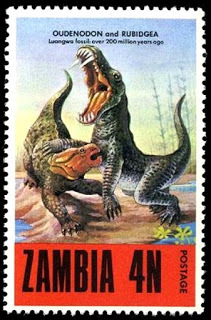 Two African therapsids - the gorgonopsid Rubidgea battling a dicynodont Oudenodon, as depicted on a postage stamp issued in 1973 by Zambia, from my personal collection (© Zambia postal service)
Two African therapsids - the gorgonopsid Rubidgea battling a dicynodont Oudenodon, as depicted on a postage stamp issued in 1973 by Zambia, from my personal collection (© Zambia postal service)THE FRAGILE, STINGING SEA-FLOWERS OF MEDUSA
Needless to say, no documentation of real-life gorgon namesakes could be complete without considering the most famous example of all, named specifically after the most famous gorgon of all – Medusa herself.
In the phylum Cnidaria, there are two basic body forms, both of which are produced by many species, but only one or the other by some. The two body forms are the sessile, stalk-bodied, tentacle-headed, hydra-like polyp; and the free-swimming, umbrella-shaped, often (but not always) tentacle-fringed, jellyfish-like medusa. The principal taxonomic classes of cnidarian are Hydrozoa (the hydrozoans, including the hydras, freshwater jellyfishes, and siphonophores), Staurozoa (the stalked jellyfishes), Scyphozoa (the true jellyfishes), Cubomedusae (the box jellyfishes), and Anthozoa (the sea anemones and corals). Certain hydrozoans, scyphozoans, and cubomedusans all produce a medusa form, many of which are usually equipped with long stinging tentacles that fancifully resemble the living snakelock hair fringing the dread face of Medusa, thereby earning the cnidarian medusa form its name, as coined for it in 1752 by none other than Linnaeus himself.
And so, what better way to bring to a memorable close our visit to Medusa's menagerie than to savour some of the most extravagantly exquisite illustrations ever produced of the varied types of cnidarian medusae, often resembling bizarre, exotic sea-flowers, as contained within Hackel's artistic masterpiece Kunstformen der Natur ('Art Forms in Nature'), published in 1904. Please click the images to enlarge them.
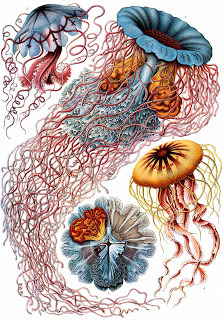 Three species of Discomedusae, true jellyfishes belonging to the class Scythozoa (public domain)
Three species of Discomedusae, true jellyfishes belonging to the class Scythozoa (public domain)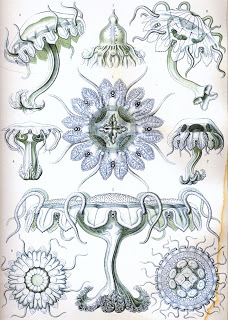 More Discomedusae (public domain)
More Discomedusae (public domain)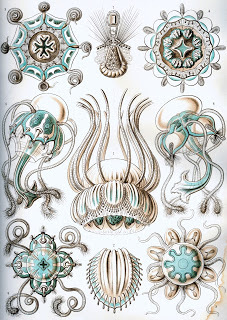 Various species of Narcomedusae, a hydrozoan order whose species normally lack a polyp stage (public domain)
Various species of Narcomedusae, a hydrozoan order whose species normally lack a polyp stage (public domain)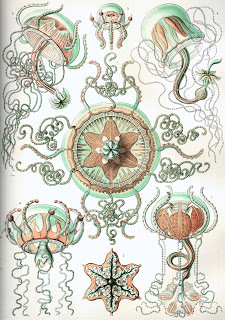 Various species of Trachymedusae, another hydrozoan order whose species never produce a polyp stage, only reproducing sexually via medusae (public domain)
Various species of Trachymedusae, another hydrozoan order whose species never produce a polyp stage, only reproducing sexually via medusae (public domain)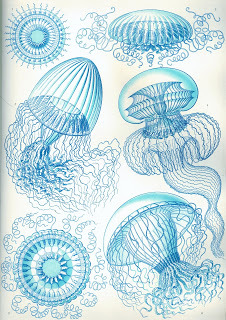 Various species of Leptomedusae or thecate hydroids, a hydrozoan order whose species produce ensheathed polyp colonies (the protective sheath is known as a theca or perisarc), as well as sexually-reproducing medusae (public domain)
Various species of Leptomedusae or thecate hydroids, a hydrozoan order whose species produce ensheathed polyp colonies (the protective sheath is known as a theca or perisarc), as well as sexually-reproducing medusae (public domain)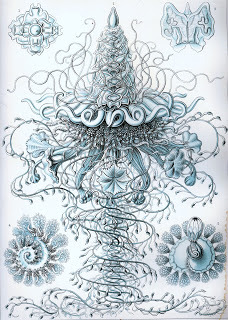 Views of the siphonophore Physophora hydrostatica – like all siphonophores, what looks like a single large complex organism equipped with bell, tentacles, etc, is in reality a super-organism, consisting of an entire colony of highly-specialised individual organisms, each of which is one of the super-organism's organs, e.g. one organism is the bell, another organism is one of the tentacles, yet another is another of the tentacles, etc (public domain)
Views of the siphonophore Physophora hydrostatica – like all siphonophores, what looks like a single large complex organism equipped with bell, tentacles, etc, is in reality a super-organism, consisting of an entire colony of highly-specialised individual organisms, each of which is one of the super-organism's organs, e.g. one organism is the bell, another organism is one of the tentacles, yet another is another of the tentacles, etc (public domain)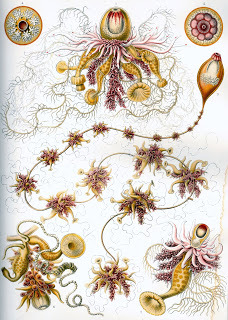 More siphonophores (public domain)
More siphonophores (public domain) 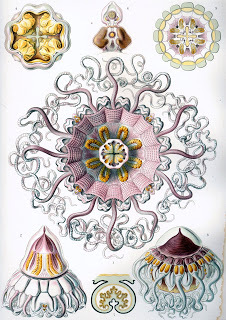 Views of the helmet jellyfish Periphylla periphylla, a deepsea species of true jellyfish or scyphozoan (public domain)
Views of the helmet jellyfish Periphylla periphylla, a deepsea species of true jellyfish or scyphozoan (public domain)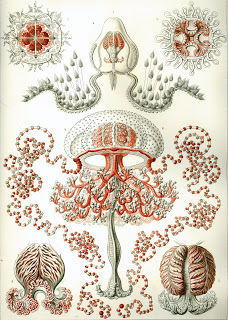 Various species of Anthomedusae, the athecate hydroids, a hydrozoan order whose species produce polyp colonies not ensheathed in a protective sheath (the theca or perisarc), as well as sexually-reproducing medusae (public domain)
Various species of Anthomedusae, the athecate hydroids, a hydrozoan order whose species produce polyp colonies not ensheathed in a protective sheath (the theca or perisarc), as well as sexually-reproducing medusae (public domain)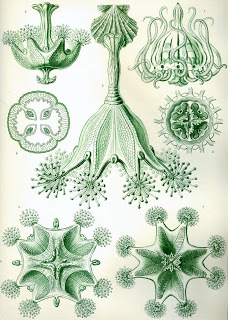 Various species of Stauromedusae, the stalked jellyfishes, sole members of the taxonomic class Staurozoa, whose medusae are attached rather than free-swimming (public domain)
Various species of Stauromedusae, the stalked jellyfishes, sole members of the taxonomic class Staurozoa, whose medusae are attached rather than free-swimming (public domain) Various species of Cubomedusae, the box jellyfishes, which include Flecker's sea wasp Chironex fleckeri, the world's most venomous jellyfish, yet still-undiscovered by science in Haeckel's time, and remaining so until the mid-1950s (public domain)
Various species of Cubomedusae, the box jellyfishes, which include Flecker's sea wasp Chironex fleckeri, the world's most venomous jellyfish, yet still-undiscovered by science in Haeckel's time, and remaining so until the mid-1950s (public domain)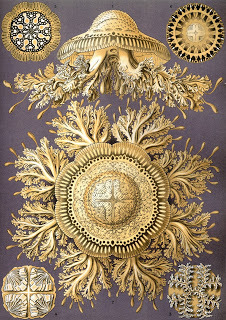 More Discomedusae, true jellyfishes belonging to the class Scyphozoa (public domain)
More Discomedusae, true jellyfishes belonging to the class Scyphozoa (public domain) 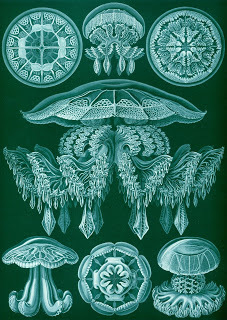 Various species of rhizostome Discomedusae, true jellyfishes belonging to Scyphozoa (public domain)
Various species of rhizostome Discomedusae, true jellyfishes belonging to Scyphozoa (public domain)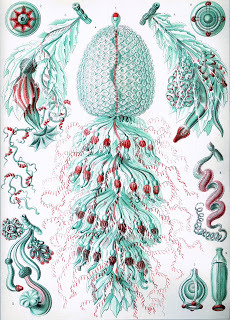 More siphonophores (public domain)
More siphonophores (public domain) 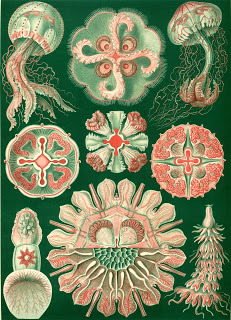 More species of Discomedusae, including the medusa of the familiar moon jellyfish Aurelia aurita (top centre) (public domain)
More species of Discomedusae, including the medusa of the familiar moon jellyfish Aurelia aurita (top centre) (public domain)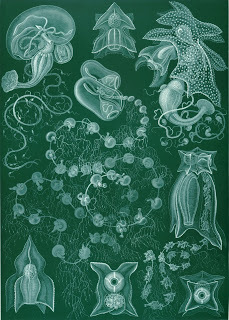 Still more siphonophores (public domain)
Still more siphonophores (public domain)Also commemorating Medusa, incidentally, are Medusaceratops lokii (also commemorating Loki, the Norse god of evil), a late Cretaceous species of ceratopsian horned dinosaur, which inhabited what is now Montana, USA, and was formally named in 2010; and Medusagyne oppositifolia, the critically-endangered Seychelles jellyfish tree, earning its genus name from the fancied resemblance of its flower's gynoecium to Medusa's head, plus its common name from the distinctive jellyfish-like shape of its dehisced fruit, and believed extinct until some individuals were discovered on the island of Mahé during the 1970s.
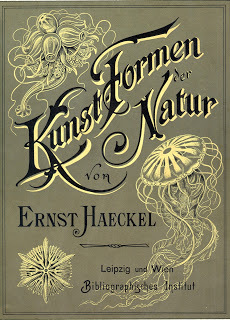 The front cover of Prof. Ernst Haeckel's truly beautiful book, Kunstformen der Natur (1904) (public domain)
The front cover of Prof. Ernst Haeckel's truly beautiful book, Kunstformen der Natur (1904) (public domain)And speaking of jellyfishes: how ironic it is that in certain instances, creatures as beautiful as cnidarian medusae are also potentially lethal, due to the potency of the venom produced by their tentacles' nematocysts or stinging cells. Then again, how can we really expect anything else from organisms that are, after all, specifically named after a legendary figure feared not only for her thanatic eyes but also for the deadly nature of her living tresses?
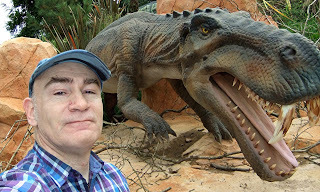 Me and my mate the gorgonopsid (© Dr Karl Shuker)
Me and my mate the gorgonopsid (© Dr Karl Shuker)UPDATE - 31 August 2015
Today, I received a scan of this very different, highly original, and totally delightful Medusa illustration, drawn by crypto-enthusiast and friend Jane Cooper. Hidden amongst Medusa's traditional serpentine hair strands are several that are inspired by all manner of other creatures, including some notable cryptozoological ones, such as Nessie, the Mongolian death worm, and the Dover demon, as well as a very imposing terror bird. How many can you spot and identify? Thanks Jane!!
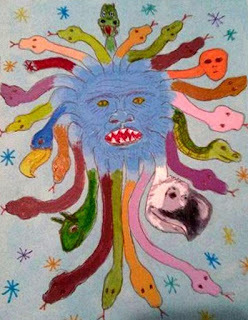 Medusa goes crypto!! - click to enlarge (© Jane Cooper)
Medusa goes crypto!! - click to enlarge (© Jane Cooper)
Published on August 30, 2015 15:55
August 29, 2015
MY LATEST BOOK, A MANIFESTATION OF MONSTERS, IS NOW AVAILABLE TO PRE-ORDER ON AMAZON!
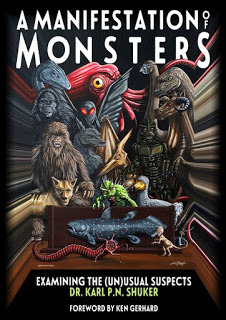 Front cover of my latest book, A Manifestation of Monsters (© Dr Karl Shuker/Michael J. Smith/Anomalist Books)
Front cover of my latest book, A Manifestation of Monsters (© Dr Karl Shuker/Michael J. Smith/Anomalist Books)I'm delighted to announce that my latest book, A Manifestation of Monsters: Examining the (Un)Usual Subjects , published by Anomalist Books and containing a foreword by my good friend and fellow cryptozoologist Ken Gerhard, is now available to pre-order on Amazon.
Please click its title above to access its own dedicated web-page on my website, which includes direct clickable links to its ordering pages on Amazon's American and British sites.
 Fellow cryptozoologist and good friend Ken Gerhard, who very kindly wrote the foreword to my new book - thanks, Ken!! (© Ken Gerhard)
Fellow cryptozoologist and good friend Ken Gerhard, who very kindly wrote the foreword to my new book - thanks, Ken!! (© Ken Gerhard) And here's a summary of what inspired this 22nd book of mine and what it contains:
During the 30 years in which I have been investigating and documenting mystery creatures, my writings have been guided by countless different inspirations, but what inspired this present book was a spectacular work of art. Namely, the wonderful illustration that now graces its front cover, which was prepared by Michael J. Smith, an immensely talented artist from the USA, and which I first saw in 2012. It depicts no less than 17 cryptids and other controversial creatures, including the Loch Ness monster, bigfoot, coelacanth, mokele-mbembe, Jersey devil, chupacabra, Mongolian death worm, Tasmanian wolf, dogman, giant squid, skunk ape, and dodo.
Ever since seeing it, my notion of preparing a book inspired directly by this painting and the eclectic company of entities that it portrays has always stayed with me, but the fundamental problem that I faced if I were to do so was how to categorise them collectively.
What single term could be used that would effectively embrace, encompass, and enumerate this exceptionally diverse array of forms, as well as the range of additional creatures that would also be included in the book? 'Cryptid' was not sufficiently comprehensive, nor was 'mystery creature' or 'unknown animal', because some of the depicted beasts seem to exist far beyond the perimeters - and parameters - of what is traditionally deemed to be the confines of cryptozoology. Consequently, I eventually concluded that there was only one such term that could satisfy all of those requirements – indeed, it was tailor-made for such a purpose. The term? What else could it be? 'Monster'!
Derived from the Latin noun 'monstrum' and the Old French 'monstre', 'monster' has many different modern-day definitions - a very strange, frightening, possibly evil (and/or ugly) mythical creature; something huge and/or threatening; a malformed, mutant, or abnormal animal specimen; and even something extraordinary, astonishing, incredible, unnatural, inexplicable. These definitions collectively cover all of this book's subjects – and so too, therefore, does the single word 'monster' from which the definitions derive.
Thus it was that this became a book of monsters, but not just a book – a veritable manifestation of monsters. That is, a unique exhibition, a singular gathering, an exceptional congregation of some of the strangest, most mystifying, and sometimes truly terrifying creatures ever reported - still-unidentified, still-uncaptured, still-contentious. Even 'mainstream' species like the dodo and coelacanth, whose reality and zoological identity are fully confirmed, still succeed in eliciting controversies, and are veritable monsters - the dodo having been referred to by various researchers as a monstrous dove, and the coelacanth as a resurrected prehistoric monster.
So, if you're looking for monsters, you've certainly come to the right place, and will certainly be purchasing the right book. Just pray that once you open it and encounter the incredible creatures lurking inside, you don't live to regret your bravery – or foolishness - in having done so. In fact, just pray that you do live...
Hoping that you enjoy encountering my manifestation of monsters!!
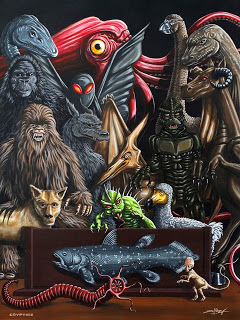 Michael J. Smith's spectacular original artwork, 'Cryptids', which inspired my book and which now appears on its front cover – thanks, Michael!! (© Michael J. Smith)
Michael J. Smith's spectacular original artwork, 'Cryptids', which inspired my book and which now appears on its front cover – thanks, Michael!! (© Michael J. Smith)
Published on August 29, 2015 17:10
August 28, 2015
ANTLERED ELEPHANTS - OR UNLIKELY UINTATHERES?
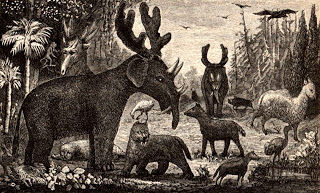 'Antlered elephants' and other North American prehistoric fauna from the Eocene epoch in what is today Wyoming, USA, as depicted in William D. Gunning's book Life History of Our Planet (1881) (public domain)
'Antlered elephants' and other North American prehistoric fauna from the Eocene epoch in what is today Wyoming, USA, as depicted in William D. Gunning's book Life History of Our Planet (1881) (public domain)Have there ever been antlered elephants? Not as far as we know – so how can the extraordinary illustration presented above be explained? The answer dates back to the intense rivalry between two eminent American fossil collectors, resulting in the so-called Bone Wars that galvanised 19th-Century palaeontology, and focuses upon the subject of one of their most fervent bouts of competitive taxonomic classification – a long-extinct but spectacularly strange-looking group of huge ungulate mammals known as uintatheres.
Uintatheres have always held a special place in my childhood memories because the very first artistic reconstruction of a fossil mammal's likely appearance in life that I ever saw was of a Uintatherium– vibrantly depicted on one of the opening pages of my How and Why Wonder Book of Wild Animals (1962) that my mother bought for me when I was about 4 years old during the early 1960s. I read that poor, long-suffering book so many times and with such youthful enthusiasm that it eventually fell apart, but a replacement copy was soon purchased, which I still own today, so here is that wonderful, fondly-remembered illustration:
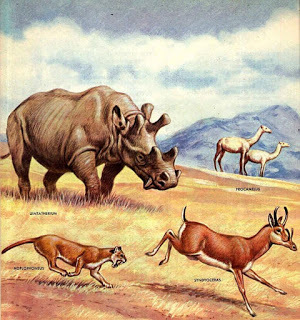 Uintatherium
depicted by Walter Ferguson in The How and Why Wonder Book of Wild Animals (© Walter Ferguson/Transworld Publishers)
Uintatherium
depicted by Walter Ferguson in The How and Why Wonder Book of Wild Animals (© Walter Ferguson/Transworld Publishers)But what are – or were – uintatheres? Named after the mountainous Uinta region of Wyoming and Utah where their first scientifically-recorded fossils were uncovered, they belonged to the taxonomic order Dinocerata ('terrible horns'). This was an early group of extremely large, superficially rhinoceros-like ungulates (but possessing claws rather than hooves), which existed from the late Palaeocene to the mid-Eocene, approximately 45 million years ago. The males of its most famous, culminating members, the uintatheres (which existed during the mid-Eocene), bore no less than three separate pairs of blunt ossicone-like horns on their heads. These consisted of a rear pair arising from the parietal bones near the back of the skull, a middle pair arising from the maxillae or upper jaw bones, and a front pair arising from the nasal bones. Their function remains uncertain, but they may have been used for defence and/or for sexual display purposes. Also, their skull was very concave and flat in shape, and with very thick walls, thus yielding so restricted a cranial cavity that the brain was surprisingly small for such sizeable animals.
Today, two major genera of uintatheres are recognised – Uintatherium and Eobasileus (plus a few less well known ones, such as Tetheopsis) – which are very similar to one another morphologically, and are distinguished predominantly by way of certain differences in skull proportions, as delineated in the following diagram and table. These originate from the definitive work on uintathere taxonomy, North Carolina University palaeontologist Dr Walter H. Wheeler's comprehensive paper 'Revision of the Uintatheres', published in 1961 as Bulletin #14 of the Peabody Museum of Natural History, Yale University.
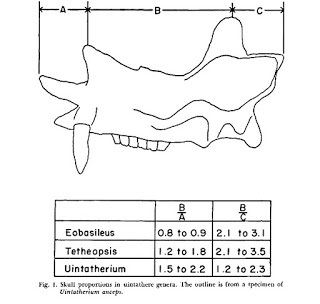 Skull proportions in uintathere genera (from Wheeler, 1961)
Skull proportions in uintathere genera (from Wheeler, 1961)Also, whereas the skull of Uintatherium was relatively broad, with the parietal bones positioned some way in front of the occiput (the skull's rearmost portion), in Eobasileus the skull was long and narrow, with the parietal horns further back and therefore much closer to the occiput.
In addition to their horns, male uintatheres also possessed a very sizeable pair of downward-curving upper tusks (they were much smaller in females), protected like scimitars by bony scabbard-resembling lower jaw down-growths. Behind each of these two tusks was a noticeable gap (diastema), separating the tusk on each side of the upper jaw from that side's first premolars. In Uintatherium, the maxillary horns were positioned directly above the diastema in each side of the upper jaw, whereas in Eobasileusthey were positioned further back, above the premolars.
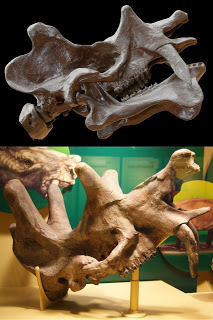 Comparing the structure of a Uintatherium anceps skull at the Muséum National d'Histoire Naturelle in Paris, France (above) with that of an Eobasileus cornutus skull at the Chicago Field Museum (below) (public domain / © Dallas Krentzel/Wikipedia)
Comparing the structure of a Uintatherium anceps skull at the Muséum National d'Histoire Naturelle in Paris, France (above) with that of an Eobasileus cornutus skull at the Chicago Field Museum (below) (public domain / © Dallas Krentzel/Wikipedia)Uintatherium was a massive browsing ungulate, up to around 13 ft long, 5.5 ft tall, and up to 2 tons in weight. Only two species of Uintatherium are recognised today – North America's U. anceps (the most famous dinoceratan of all, formally named and described in 1872 by American palaeontologist Prof. Joseph Leidy), and China's more recently-recognised U. insperatus (named and described in 1981).
Only one Eobasileus species is nowadays recognised – E. cornutus, named by fellow American palaeontologist Prof. Edward Drinker Cope in 1872. This was the largest uintathere of all, and in fact the largest land mammal of any kind during its time on Earth, with a total length of around 13 ft, standing 6.75 ft high at the shoulder, and weighing up to 4.5 tons.
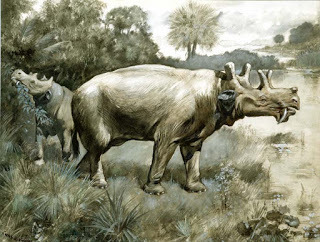 Eobasileus
as depicted masterfully and majestically by Charles Knight (public domain)
Eobasileus
as depicted masterfully and majestically by Charles Knight (public domain)Just over a century ago, however, a bewildering plethora of uintathere genera and species had been distinguished and named, due not so much to any taxonomic merit, however, but rather to the driven desire by two implacable fossil-collecting foes during the 1870s and 1880s to outdo one another in their febrile quest for palaeontological immortality and to destroy each other's scientific reputation, until their obsession eventually ruined both of them, socially and financially.
Their names? Othniel Charles Marsh (1831-1899), and Edward Drinker Cope (1840-1897).
 Othniel Charles Marsh (left) and Edward Drinker Cope (right) (public domain)
Othniel Charles Marsh (left) and Edward Drinker Cope (right) (public domain)After having been professor of vertebrate palaeontology at Yale University in New Haven, Connecticut, Marsh became the first curator at the Peabody Museum of Natural History at Yale University (the museum having been founded by his wealthy uncle, the philanthropist George Peabody). Conversely, Cope preferred field work to academic research, as a result of which he never held a major scientific post of any lengthy tenure, though he did become professor of zoology for a time at the University of Pennsylvania in Philadelphia, his home city.
Although they are most famous for their frenzied attempts to best one another in the description of new dinosaur species, Marsh and Cope also constantly challenged each another along similar lines in relation to their descriptions of new uintatheres. The regrettable, chaotic result was the creation not only of numerous new species but also of many new genera, several of which were named within the space of a single year, and all of which were unjustified, having been founded upon the most trivial, taxonomically insignificant of differences.
This sorry, farcical state of affairs is preserved today in the startling array of junior synonyms attached to the genus Uintatherium, including the nowadays long-nullified genera Dinoceras (coined by Marsh in 1872), Ditetrodon (Cope, 1885), Elachoceras (Scott, 1886), Loxolophodon (Cope, 1872), Octotomus (Cope, 1885), Tinoceras (Marsh, 1872), and Uintamastix (Leidy, 1872). Although I normally have little interest in abandoned names, I do feel a pang of regret for the loss of one particular example here – the wonderfully-named Dinoceras mirabile (synonymised with Uintatherium anceps), which was coined in 1872 by Marsh, and translates as 'marvellous terrible-horn' – a very evocative, accurate description of how this extraordinary beast would have looked in life.
 Uintatherium
as portrayed upon a postage stamp issued by Afghanistan in 1988, from my personal collection (© Afghanistan postal service)
Uintatherium
as portrayed upon a postage stamp issued by Afghanistan in 1988, from my personal collection (© Afghanistan postal service)But what has all (or any) of this to do with antlered elephants? I'm glad you asked! Because uintatheres were indeed so astounding in form, when their first fossils were discovered palaeontologists were by no means certain which creatures were their closest relatives, and how, therefore, they should be classified. Cope, who was particularly enthralled by them, was convinced that such huge ungulates must surely be related to elephants, and he even opined that they probably possessed a long nasal trunk like elephants plus a pair of very large, wide, elephantine ears, and that they should be housed with them in the taxonomic order Proboscidea, thereby conflicting yet again with Marsh's view (in 1872, Marsh had placed them within their very own order, Dinocerata). But that was not all.
Cope also speculated that their rearmost, parietal pair of horns may have been much larger than the other two pairs, possibly even branched and covered in velvet, thereby resembling the antlers of deer. And so, in various early reconstructions of their putative appearance in life, this is exactly how uintatheres were portrayed – as antlered, large-eared, trunk-wielding pachyderms, resembling the highly unlikely outcome of an equally improbable liaison between an elephant and a moose!
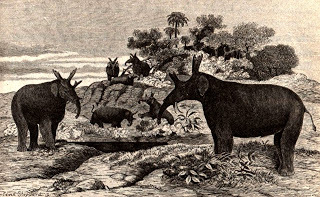 Eobasileus cornutus
with elephant ears and trunk , from an August 1873 Pennsylvania Monthly article by Edward Drinker Cope (public domain)
Eobasileus cornutus
with elephant ears and trunk , from an August 1873 Pennsylvania Monthly article by Edward Drinker Cope (public domain)True, there were certain less dramatic versions – one illustration (see above) that appeared in a Pennsylvania Monthlyarticle from August 1873 by Cope concerning the uintathere species now called Eobasileus cornutus portrayed it with tall unbranched parietal horns rather than with parietal antlers (although they are still slightly palmate at their distal edges), but did gift it with an elephant's ears and trunk (as instructed by Cope). However, the two most (in)famous examples of this specific genre of reconstruction were rather more extreme, and both of them appeared in William D. Gunning's book Life History of Our Planet (1881). One of these is the following diagrammatic reconstruction:
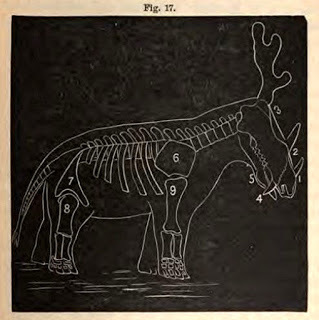 Line diagram of a Uintatherium(spelt 'Uintahtherium' here) as an antlered elephant-like beast in Gunning's book (public domain)
Line diagram of a Uintatherium(spelt 'Uintahtherium' here) as an antlered elephant-like beast in Gunning's book (public domain)Gunning's comparisons drawn between this remarkable creature and various modern-day animals were equally memorable, albeit decidedly fanciful in parts (notably its small brain allying it with the marsupials!):
"We are as astronomers taking the parallax of a distant star. The animal which roamed along the banks of that Wyoming lake is as far from us in time as the star in space. What is its parallax? what its place in the scheme of creation? The long, narrow head with skull elevated behind into a great crest, the molar teeth and arch of the cheek-bone are characters, which indicate relationship with the Rhinoceros. The absence of teeth in the premaxillaries points to the Ruminants. The vertical motion of the jaw points away from the Ruminants, towards the Carnivores. The great expansion of the pelvis, the complete radius and ulna, the shoulder-blade and the hind-foot, are characters which affiliate our animal with the Elephant. The diminutive brain would place it with the pouched Opossum.
"The horns on the maxillaries, the concavity of the crown, and the enormous side crests of the cranium are characters which remove the animal from all living types. We have found the ruins of an animal composed of Elephant, Rhinoceros, Ruminant, Marsupial, and a something unknown to the world of the living. Drawing an outline around the skeleton, we have a long head with little horns on the nose, conical horns over the eyes, and palmate horns over the ears, with pillar-like limbs supporting a massive body nearly eight feet high in the withers and six in the rump. Eliminating from its structure all that relates to the living, so many and such dominant structures remain that we cannot choose for it a name from existing orders. We will call it Uintahtherium[sic], which means, the Beast of the Uintah Mountains."
A pair of antlered elephantine uintatheres appeared in this same book's frontispiece illustration, but this time fleshed out rather than in diagrammatic form, as part of an Eocene panorama of North American mammals. The illustration in question opens this present ShukerNature post, and is also reproduced below, together with its original accompanying caption:
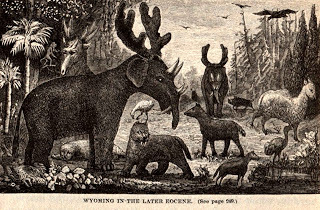 The frontispiece illustration of Gunning's book, featuring a pair of antlered uintatheres (public domain)
The frontispiece illustration of Gunning's book, featuring a pair of antlered uintatheres (public domain)By the end of the 19th Century, however, with many additional fossilised remains having been discovered in the meantime, palaeontological views regarding both the morphology and the taxonomy of the uintatheres had changed markedly. Cope's views concerniing them had been totally rejected in favour of Marsh's, thus promoting the belief still current today that these mammalian behemoths represented a lost ungulate lineage, unrepresented by (and unrelated to) any that are still alive in the modern world.
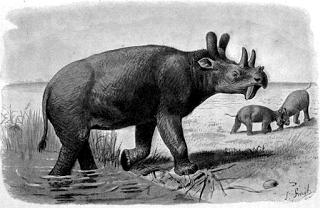 A rather more modern-looking Uintatherium as illustrated in the Reverend H.N. Hutchinson's book Extinct Monsters (1897)
A rather more modern-looking Uintatherium as illustrated in the Reverend H.N. Hutchinson's book Extinct Monsters (1897)So it was, for instance, that Uintatherium was illustrated in Extinct Monsters (1897) by the Reverend H.N. Hutchinson in much the same manner as it still is now, over a century later, shorn of its velvet-surfaced antlers and with only relatively short and blunt, unbranched horns in their stead, plus much smaller ears, and a conspicuous lack of any probiscidean trunk. The antlered elephant was no more – a non-existent fossil phantom blown swiftly away by a brisk, incoming breeze bearing new discoveries and new ideas borne from a new generation of researchers. 'Twas ever thus.
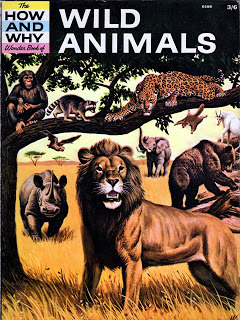 My How and Why Wonder Book of Wild Animals (1962), containing the first Uintatheriumillustration that I ever saw as a child (© Transworld Publishers)
My How and Why Wonder Book of Wild Animals (1962), containing the first Uintatheriumillustration that I ever saw as a child (© Transworld Publishers)
Published on August 28, 2015 17:27
August 26, 2015
INVESTIGATING THE LOCUST DRAGON OF NICOLAES DE BRUYN - AN ENTOMOLOGICAL ENIGMA FROM THE 16TH CENTURY
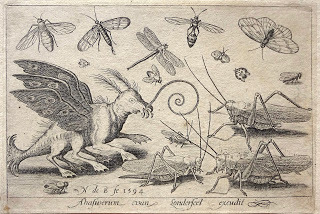 Nicolaes de Bruyn's mystifying engraving from 1594, depicting a wide range of readily-identifiable insects, plus what can only be described as a truly bizarre 'locust dragon' (public domain)
Nicolaes de Bruyn's mystifying engraving from 1594, depicting a wide range of readily-identifiable insects, plus what can only be described as a truly bizarre 'locust dragon' (public domain)As a fervent browser of bestiaries, illuminated manuscripts, and other sources of antiquarian illustrations portraying a vast diversity of grotesque, extraordinary beasts that ostensibly bear no resemblance or relation to any species known to science, I am rarely surprised nowadays by any zoological depictions that I encounter in such sources. A few days ago, however, I was not just surprised but also thoroughly bemused – bewildered, even – by a truly remarkable picture that I happened to chance upon online.
I had been idly cyber-surfing in search of interesting animal images to add to one or other of my two Pinterest albums, when I came upon the engraving to which this present ShukerNature article is devoted, and which opens it above. Yet in spite of my experience with antiquarian images, I had never before seen anything even remotely like the exceedingly bizarre creature occupying much of the left-hand side of this engraving, and its overt strangeness was such that with no further ado I immediately set forth on a quest to uncover whatever I could find out concerning it, and, in particular, to determine what on earth (or anywhere else for that matter!) it could possibly be.
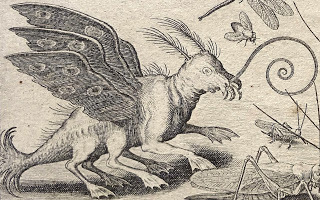 Close-up of de Bruyn's 'locust dragon' (public domain)
Close-up of de Bruyn's 'locust dragon' (public domain)The first pieces of information that I obtained were the identity of the person who had produced this baffling artwork, and its original source. The person was Nicolaes de Bruyn (1571-1656), a Flemish engraver, and as can be seen on this engraving, the date of its production was 1594. Although he is best known for his many biblically-themed engravings and his large engraved landscapes reproducing designs and paintings by other artists, he produced approximately 400 works in total, including a number that featured animals.
The original source of this particular engraving was a series of prints by de Bruyn that depicted various flying creatures. The series was entitled Volatilium Varii Generis Effigies ('Pictures of Flying Creatures of Varied Kinds'), was prepared by de Bruyn in Antwerp, and was first published by Ahasuerus van Londerseel (1572-1635) of Amsterdam. It was subsequently reissued (with van Londerseel's name neatly trimmed off!) by Carel Allard in 1663 (or shortly after – there are conflicting accounts concerning this detail).
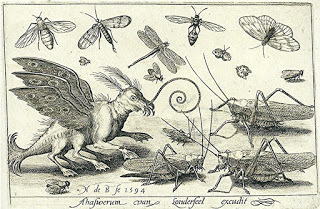 The complete engraving by de Bruyn again, his fantastical locust dragon sharing it with a wide range of accurately-portrayed insects (public domain)
The complete engraving by de Bruyn again, his fantastical locust dragon sharing it with a wide range of accurately-portrayed insects (public domain)What I find so intriguing about de Bruyn's engraving is the juxtapositioning of a fantastical monster in every sense of the term (more like a dragon, in fact, than any real beast), with a number of different types of insect whose depictions are so accurate, so natural, that they readily compare with well-executed 21st-Century equivalents and whose types can be easily identified. Thus, they include long-horned bush crickets, dipteran flies, a ladybird, a panorpid scorpionfly, a large moth, and a narrow-waisted polistid-like wasp.
Yet what if the monster is itself an insect – or is at least intended to represent one? After all, it does possess six legs (albeit ones bearing no resemblance to those of real insects), two pairs of wings (ditto), a pair of bristly antennae, and a long curling butterfly-reminiscent proboscis. But if so, what insect could it be, especially with such a curious tufted tail or abdominal tip, and why has it been portrayed in such a nightmarish, wholly inaccurate fashion, especially when all of the others are so life-like in appearance?
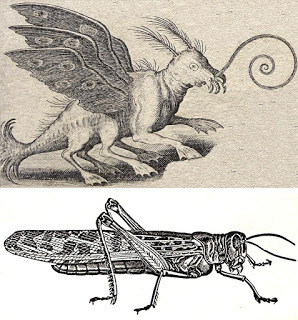 Comparison of de Bruyn's unrealistically-depicted locust dragon (top) with a realistic depiction of a locust (bottom) (public domain)
Comparison of de Bruyn's unrealistically-depicted locust dragon (top) with a realistic depiction of a locust (bottom) (public domain)A copy of this engraving is housed in the collections of Amersterdam's celebrated Rijksmuseum, and when I accessed their record for it (click here ) I was nothing if not startled by the record's claim that the engraving's mystery monster is meant to represent a locust! (The locust species in question is presumably the infamously destructive Old World desert locust Schistocerca gregaria.) Needless to say, however, I've certainly never seen a locust that looks like this, and the Rijksmuseum's record for the engraving contains no clues regarding the raison d'être for its surreal portrayal here.
The only other site encountered by me that offers any thoughts on the matter is Strange Science (click here to see its entry for this engraving). Here, its author notes that in her book Curious Beasts (2013), Alison E. Wright, a curator of prints and drawings at the British Museum, has stated that this image "offers particular insights into the hazards of copying" (an example of it is held in the museum's art collections). In other words, de Bruyn may not have based his engraving upon an actual locust specimen that he had personally seen, but had instead either relied upon a verbal description of one that he had then interpreted extremely imperfectly in visual form, or had simply copied an inaccurate earlier depiction of a locust. In my opinion, however, both of these options are untenable when applied to de Bruyn.
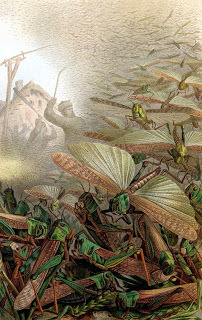 Chromolithograph from 1890 of a locust swarm (public domain)
Chromolithograph from 1890 of a locust swarm (public domain)This is because, as noted earlier here, quite a proportion of de Bruyn's other artworks are biblical in theme. And as plagues of locusts were certainly a biblical occurrence, and are referred to in the Bible's text, one would therefore expect de Bruyn to be familiar with the appearance of this insect. The most famous biblical locust plague was the Eighth Plague of Egypt, sent by God as a curse upon Pharaoh, and documented as follows in the Book of Exodus 10: 12-20:
[12] And the Lord said unto Moses, Stretch out thine hand over the land of Egypt for the locusts, that they may come up upon the land of Egypt, and eat every herb of the land, even all that the hail hath left.
[13] And Moses stretched forth his rod over the land of Egypt, and the Lord brought an east wind upon the land all that day, and all that night; and when it was morning, the east wind brought the locusts.
[14] And the locusts went up over all the land of Egypt, and rested in all the coasts of Egypt: very grievous were they; before them there were no such locusts as they, neither after them shall be such.
[15] For they covered the face of the whole earth, so that the land was darkened; and they did eat every herb of the land, and all the fruit of the trees which the hail had left: and there remained not any green thing in the trees, or in the herbs of the field, through all the land of Egypt.
[16] Then Pharaoh called for Moses and Aaron in haste; and he said, I have sinned against the Lord your God, and against you.
[17] Now therefore forgive, I pray thee, my sin only this once, and intreat the Lord your God, that he may take away from me this death only.
[18] And he went out from Pharaoh, and intreated the Lord.
[19] And the Lord turned a mighty strong west wind, which took away the locusts, and cast them into the Red Sea; there remained not one locust in all the coasts of Egypt.
[20] But the Lord hardened Pharaoh’s heart, so that he would not let the children of Israel go.
In any case, even without the specific biblical art link, locust plagues were sufficiently well known in de Bruyn's day for there surely to be no likelihood that he would be unfamiliar with this insect's appearance. Also, readily identifiable depictions of desert locusts date back thousands of years, exemplified by various portrayals in certain ancient Egyptian sites, such as the following one:
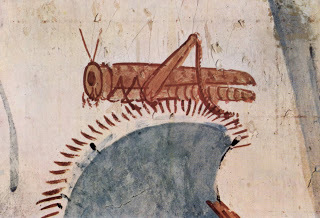 Readily identifiable locust depiction from a hunt mural in the grave chamber of Horemhab (the last pharaoh of ancient Egypt's 18th Dynasty), dating from c.1422-1411 BC (public domain)
Readily identifiable locust depiction from a hunt mural in the grave chamber of Horemhab (the last pharaoh of ancient Egypt's 18th Dynasty), dating from c.1422-1411 BC (public domain)Moreover, as shown by his portrayals of long-horned bush crickets in the same engraving, de Bruyn was eminently capable of rendering the basic orthopteran (grasshopper/cricket) form with meticulous accuracy.
Consequently, I feel that we need to look elsewhere for a satisfactory solution to the mystery of why he should have included a veritable locust dragon amid an array of skilfully-depicted, readily-recognisable insect forms.
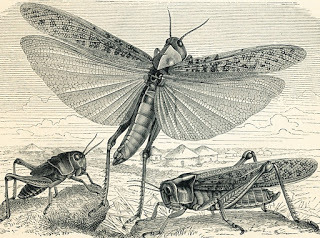 Close-up of a realistically-portrayed locust about to take flight, showing how very different its wings are from those of de Bruyn's locust dragon (public domain)
Close-up of a realistically-portrayed locust about to take flight, showing how very different its wings are from those of de Bruyn's locust dragon (public domain)Of course, in more religious, less secular times, locust plagues were traditionally seen as punishments sent by God in response to humanity's misdeeds. So might it be that de Bruyn purposefully devised his locust dragon to serve as a demonic-looking personification of such divine intervention? Or, alternatively, could it be that its presence in the engraving was actually indicative of a much more light-hearted state of mind relative to its artistic creator?
Not so long ago here on ShukerNature I posted an article of mine dealing with snail-cats and other illuminated manuscript marginalia of the zoomythological variety (click here ). In it, I noted that the preponderance of bizarre, comical, and sometimes thoroughly outrageous monsters and impossible hybrids portrayed in the margins of medieval tracts by monks and other illustrators often had no relevance whatsoever to the text, and seemed to have been included for no good reason at all – other than simply to relieve the tedium experienced by the illustrators during the long periods of time required to copy or create such manuscripts, and that these marginalia monsters frequently were deliberately subversive or humorous, thereby helping to lighten their creators' moods.
Might the locust dragon of de Bruyn owe its origin to a similar reason – a wry joke perpetrated amidst what was otherwise a relatively dry, technical art commission? Certainly, its weird appearance cannot be due to ignorance on the part of the medieval illustrators, because there are several notable illuminated manuscripts in existence containing accurate portrayals of locusts.
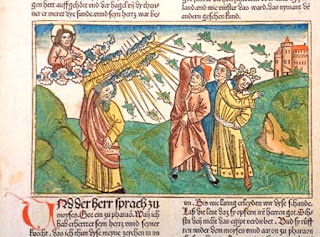 A plague of locusts depicted in a bible produced by Nuremberg-based printer/publisher Anton Koberger in 1483 (public domain)
A plague of locusts depicted in a bible produced by Nuremberg-based printer/publisher Anton Koberger in 1483 (public domain)Over 400 years has passed since de Bruyn created his anomalous locust dragon, so we may never know the answer. Yet if nothing else, this entomological enigma – one that, despite its implausible morphology, was nevertheless drawn with Bruyn's typical flair and imbued with vibrant vitality – remains a wonder, and one that I am very happy to have rescued from centuries of obscurity and introduced at last onto the global cryptozoological stage.
If anyone reading this ShukerNature blog article has any additional information concerning its subject, I'd greatly welcome any details that you'd care to post here.
 Painting from 1923 depicting swarming locusts (public domain)
Painting from 1923 depicting swarming locusts (public domain)To discover plenty of other strange and spectacular dragon forms, be sure to check out my recent book Dragons in Zoology, Cryptozoology, and Culture .
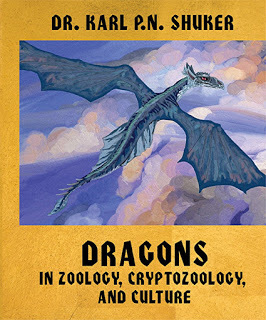
Published on August 26, 2015 12:58
August 25, 2015
MY 500TH SHUKERNATURE POST! – PRESENTING THE TOP TEN SHUKERNATURE POSTS OF ALL TIME: FROM BLACK LIONS AND MERMAIDS TO POODLE MOTHS AND PENIS SNAKES!
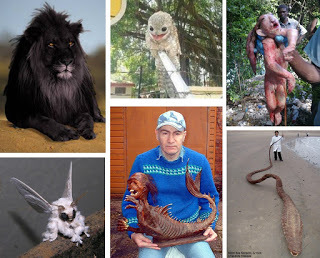 Subjects documented in six of my all-time Top Ten ShukerNature blog posts (mermaid photo © Dr Karl Shuker; Venezuelan poodle moth photo © Arthur Anker; giant sea serpent gaff photo © Takeshi Yamada; © of the other photos unknown to me)
Subjects documented in six of my all-time Top Ten ShukerNature blog posts (mermaid photo © Dr Karl Shuker; Venezuelan poodle moth photo © Arthur Anker; giant sea serpent gaff photo © Takeshi Yamada; © of the other photos unknown to me)Welcome to my 500th ShukerNature blog post! To mark this momentous occasion, I have pleasure in presenting for your entertainment and interest the following equally momentous list – the Top Ten ShukerNature posts of all time, based upon hit counts. And here they are, each one with its own clickable direct link to the post itself.
#1: BLACK LIONS – MANIPULATION, MELANISM, AND MOZAICISM Posted: 12 June 2012Hits count: 1,155,307
#2: MERMAID BODY FOUND? IN SEARCH OF FOLK WITH FINS Posted: 1 August 2012Hits count: 209,972
#3: MYSTERY OF THE VENEZUELAN POODLE MOTH – HAVE YOU SEEN THIS INSECT??
Posted: 22 August 2012Hits count: 114,688
#4: HALF-HUMAN HALF-RABBIT HYBRID – THE TRAGIC TRUTH? Posted: 13 February 2014Hits count: 104,393
#5: THE TRUTH ABOUT BLACK PUMAS – SEPARATING FACT FROM FICTION REGARDING MELANISTIC COUGARS Posted: 16 August 2012Hits count: 92,565
#6: THE TRUTH ABOUT BRAZIL'S AMAZING 'PENIS SNAKE' – NOT A SNAKE, AND CERTAINLY NOT A… Posted: 3 August 2012.Hits count: 76,659
#7: GIANT SEA SERPENTS AND CHUPACABRA SNAILS – WELCOME TO THE MONSTROUS MENAGERIE OF TAKESHI YAMADA Posted: 2 June 2011Hits count: 70,809
#8: EXPOSING ANOTHER BLACK LION PHOTOGRAPH AS A FAKE Posted: 1 October 2012Hits count: 58,418
#9: PORTRAITS OF A POTOO – NEITHER AN AVIAN ALIEN NOR THE BIRD FROM HELL! Posted: 26 January 2014.Hits count: 44,933
#10: GIANT ANACONDAS AND OTHER SUPER-SIZED CRYPTOZOOLOGICAL SNAKES
Posted: 20 September 2013Hits count: 42,213
Analysing this list, several intriguing if not readily explainable facts swiftly emerge.
First and foremost, melanistic cats – most especially black lions – clearly hold an abiding fascination for ShukerNature readers. The popularity of my all-time #1 blog post, exposing various online black lion photographs as photo-manipulated hoaxes, is truly, outrageously, and – above all else – inexplicably phenomenal! What on earth is it about black lions that should have generated well over 1 million hits for this particular post since I uploaded it just over 3 years ago, far more than any other ShukerNature post, and continuing to add to that count by the thousands each week?
Collectively, ShukerNature's 500 posts have garnered a total hits count of just over 5.1 million, which means that this one single post has contributed more than 20% of that total all by itself! Nor does it end there. A follow-up post of mine exposing a further black lion photo as yet another hoax also makes the all-time Top Ten ShukerNature posts list (coming in at #8), and my examination of the highly contentious issue of whether black pumas exist is at #5.
Equally perplexing is why four of the ten posts in this all-time Top Ten list originated from the very same month, August 2012, bearing in mind that I have been posting on ShukerNature from 20 January 2009 right up to the present day, and on a regular basis throughout that sizeable time span too. What was/is so special about that specific month, therefore, particularly as the four posts in question from it deal with four entirely different subjects? True, the poodle moth was attracting tremendous online interest at the time of my post, so that would definitely have helped focus attention upon it here on my blog too. And the term 'penis snake', as invented by the media for it, no doubt explains why a large but hitherto highly-obscure species of aquatic amphibian lacking limbs and lungs has received such a high hits count on here.
Certainly, there is no doubt that photos of weird animals that have gone viral online prove popular subjects for ShukerNature posts, especially those posts that investigate what the creatures portrayed in such photos are and whether such photos are genuine or fake. The success of my two black lion posts exemplify this trend, as do those dealing respectively with the poodle moth, the potoo, the alleged half-human half-rabbit hybrid, and the many bizarre beasts created by Takeshi Yamada.
As for the two remaining posts in this list, dealing with merfolk and giant snakes respectively, these are perennially popular cryptozoological subjects. Consequently, their presence should come as no surprise.
Looking back one last time at this all-time Top Ten list, there is no doubt that I could never have predicted which of my 500 ShukerNature posts would have made the cut. And when uploading the first of my black lion posts back in June 2012, a post that took no more than half an hour to prepare, I never dreamed even for an instant that it would become the runaway ShukerNature success story that it has done and still is, seemingly destined never to be overtaken by any other post on this blog of mine, regardless of its subject, and continuing to increase its count by significant amounts on a daily basis.
But what about the other nine posts in this list? Will they still be in the Top Ten when or if a 1000th ShukerNature post is uploaded one day? Who can say? If I've derived nothing else from this list, I have definitely learnt from it to expect the unexpected – which only serves to increase my passion for preparing further ShukerNature posts in the future, as well as my fervent hope that you will continue to enjoy reading and re-reading them. So here's to the next 500, and thank you all as ever for your continuing encouragement and interest in my researches and writings!
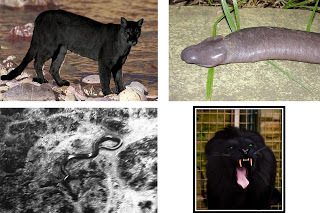 Subjects documented in the remaining four of my all-time Top Ten ShukerNature blog posts (photo-manipulated black puma photo © Dr Karl Shuker; giant python photo © Colonel Remy van Lierde; penis snake photo © Matt Roper; © of photo-manipulated black lion photo unknown to me)
Subjects documented in the remaining four of my all-time Top Ten ShukerNature blog posts (photo-manipulated black puma photo © Dr Karl Shuker; giant python photo © Colonel Remy van Lierde; penis snake photo © Matt Roper; © of photo-manipulated black lion photo unknown to me)
Published on August 25, 2015 07:05
August 21, 2015
THE BEAST OF GÉVAUDAN - WOLF, MAN...OR WOLF-MAN?
 One of numerous differing depictions of the infamous Beast of Gévaudan prepared in France, Germany, or elsewhere in Europe during the 1700s (public domain)
One of numerous differing depictions of the infamous Beast of Gévaudan prepared in France, Germany, or elsewhere in Europe during the 1700s (public domain)Between June 1764 and June 1767, a hideous series of killings, as grisly as they were plentiful (between 80 and 113 human victims, plus many injured survivors), occurred in a village-speckled district of Lozère, southeastern France, called Gévaudan. Their perpetrator became known as the Beast of Gévaudan, but more than two centuries of speculation have failed to stem the controversy regarding its precise identity. Just what was the Beast of Gévaudan? An animal? A man? Or something more?
Its first recorded victim was Jeanne Boulet, a 14-year-old peasant girl from the mountain village of Saint Etienne de Lugdares, who was slaughtered on 30 June 1764 while tending a few sheep and cows on the hills of the Vivarais. Some villagers discovered her corpse - minus its heart, which had been savagely ripped out of her body. Many other victims followed, most of which were women or children, whom the Beast attacked by springing at their throat. Some were subsequently devoured, others were simply torn apart in a frenzy of insatiable blood-lust, with decapitation and dismemberment occurring on a regular basis. Those that survived often claimed that the Beast gave voice to a loud horse-like neighing or laugh-like cry, had hind legs longer than its forelegs, and a conspicuously large head.
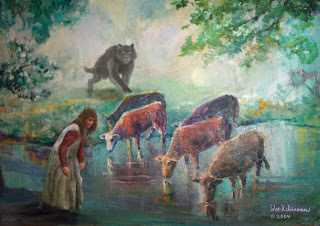 A very atmospheric depiction of the Beast stalking poor doomed Jeanne Boulet (© William M. Rebsamen)
A very atmospheric depiction of the Beast stalking poor doomed Jeanne Boulet (© William M. Rebsamen)During its three-year reign of terror, the Beast was hunted by countless people and parties. Notable among these was Jean-Baptiste Duhamel, a dragoon captain stationed close to Gévaudan, who took charge of the hunt for the Beast in early November 1764, launching a massive search for it that featured over 20,000 participants, but all to no avail. By February 1765, the Beast had attracted such widespread attention in France that King Louis XV personally became involved in the pursuit of this rapacious phantom - sending to Gévaudan one of his country's most renowned hunters, Jean Charles Marc Antoine Vaumesie Denneval (d'Enneval), equipped with six of his most efficient bloodhounds, but like Duhamel he failed to achieve any success.
Having said that, on several occasions the Beast's pursuers had encountered a huge wolf-like beast actually in the process of attacking its victim, but even though they had shot the creature it had always managed to escape - seemingly wounded, but never fatally. This apparent invulnerability to gunfire inspired many priests and other religious men to deem it a supernatural entity, a non-corporeal embodiment of evil that could not be destroyed by conventional means. Some even claimed that it had been sent as a punishment for humanity's own evil.
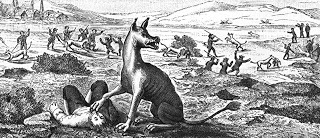 Many Beast depictions were adaptations of earlier ones – this one is an adaptation of the more detailed 1765 version opening this present ShukerNature blog article, but the latter's canine snout has been replaced here by a pig-like one, making the Beast look even stranger (public domain)
Many Beast depictions were adaptations of earlier ones – this one is an adaptation of the more detailed 1765 version opening this present ShukerNature blog article, but the latter's canine snout has been replaced here by a pig-like one, making the Beast look even stranger (public domain)Then came the shooting of 21 September 1765. The king's personal gun-carrier, François Antoine (aka Antoine de Beauterne), had been tracking the Beast throughout that day in the woods near the village of Pommier, accompanied by 40 local hunters, when without warning their quarry appeared at the bottom of the Béal Ravine. It was shot several times, finally dropping down dead as it attempted (yet again) to escape.
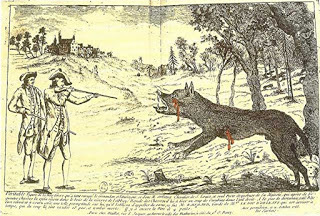 The shooting of the first Beast (public domain)
The shooting of the first Beast (public domain)It appeared to be an enormous black wolf Canis lupus - measuring around 6 ft long, standing 32 in high, and weighing 143 lb, equipped with a formidable pair of 1.5-in-long fangs and 40 teeth in total. Interestingly, wolves normally possess 42 teeth, and some scholars have suggested that this Beast might have been a wolf-dog hybrid, rather than a pure-bred wolf.
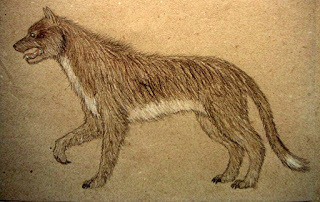 German cryptozoologist Markus Bühler's restoration of the first Beast's possible appearance (© Markus Bühler)
German cryptozoologist Markus Bühler's restoration of the first Beast's possible appearance (© Markus Bühler)Dubbed the Wolf of Chazes after the nearby Abbey of Chazes, its stuffed corpse was exhibited at the king's court for a time, before being transferred to Paris's Museum of Natural History, where it was retained until the early 1900s (what happened to it then is currently a mystery) - but the killings did not stop. True, there were no published reports, but this was on the express order of the king, who was anxious to contain the panic that this macabre epidemic of murders since June 1764 had generated. Eventually, however, news of the continuing series of deaths could no longer be suppressed - and the rest of France learnt to its horror that the deadly Beast of Gévaudan (or something else behaving very like it?) was still alive.
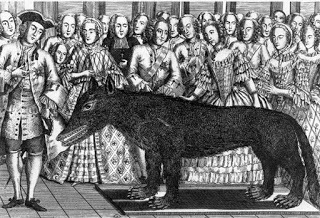 The first Beast, prepared as a stuffed taxiderm specimen for display (public doman)
The first Beast, prepared as a stuffed taxiderm specimen for display (public doman)Several creatures suspected of being the Beast were dispatched over the next two years (while identities suggested then and since for this terrifying creature ranged far beyond dogs and wolves, to embrace such exotic escapees as lions, tigers, black panthers, baboons, wolverines, and hyaenas). Nevertheless, it was not until 19 June 1767 that the Beast's hideous onslaughts were finally halted for good. This was when, during a hunt organised by the Marquis d'Apcher, a huge dog-like creature was shot dead at Mount Chauvet by local hunter Jean Chastel after it had slowly emerged from a thicket. The Beast's carcase was autopsied by the king's notary, Roch Etienne Marin, but no definite identification was reached, although the Marin did opine that this daunting creature might once again be a wolf-dog hybrid, as in his view it looked very different from ordinary wolves seen previously in this region. Interestingly, however, according to a list of dimensions and other features compiled by Marin, which was rediscovered in 1958 after having long been thought lost, the creature possessed 36 teeth (i.e. six fewer than a wolf, but only two more than a hyaena).
Afterwards, the carcase was stuffed and exhibited for a time in a number of villages before being taken to the king, but by then it had begun to decompose, so it was supposedly buried in an unmarked location somewhere within the huge garden of the king's castle. This would have been a great tragedy if true (but it wasn't – see later), because some accounts indicated that the creature's unusual appearance was by no means confined to its great size. Reported descriptions and contemporary depictions of the Beast's pelage varied greatly. According to certain ones, it was reddish, according to various others it was blackish, with (or without) a white patch on its chest (or even a long white ventral stripe), mottled or brindled elsewhere, and with a dark stripe running down its back. Moreover, its feet were said to bear very long, sturdy claws, which in some accounts were even likened to hooves.
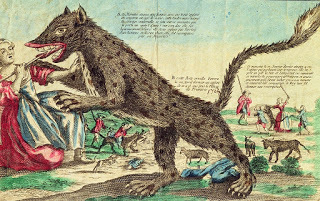 18th-Century portrayal of the Beast as a huge, mottled, grey-furred, white-breasted, long-tailed canine creature (public domain)
18th-Century portrayal of the Beast as a huge, mottled, grey-furred, white-breasted, long-tailed canine creature (public domain)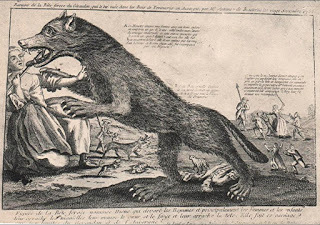 An unmottled, unicoloured, shorter-tailed version of the previous Beast portrayal (public domain)
An unmottled, unicoloured, shorter-tailed version of the previous Beast portrayal (public domain)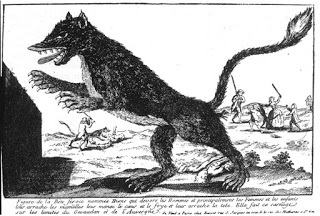 An unmottled, black-furred, white-breasted, long-tailed version of the first of these three Beast portrayals (public domain)
An unmottled, black-furred, white-breasted, long-tailed version of the first of these three Beast portrayals (public domain)This latter claim concerning hooves has in turn led to a very extreme identity for the Beast having been offered by several online cryptozoological enthusiasts – namely, a surviving mesonychian, or, more specifically, a modern-day representative of Andrewsarchus mongoliensis, the largest carnivorous land mammal presently known to science. Mesonychians constituted a taxonomic order of early carnivorous ungulates that according to the current fossil record existed from the early Palaeocene to the early Oligocene (approximately 63 to 30 million years ago), although most had vanished by the end of the Eocene. They are believed to have originated in Asia, where they were very diverse, but subsequently radiated out into Europe too, as well as reaching North America - where they evolved into some huge forms. However, they were eventually out-competed by the emerging true carnivores or carnivorans, i.e. belonging to the order Carnivora (dogs, cats, bears, mustelids, hyaenas, viverrids, etc).
Yet despite being carnivorous, predatory creatures, because they were ungulates the mesonychians possessed hooves, not claws, which is what inspired the mesonychian identity for the Beast of Gévaudan. However, not only would the survival of a mesonychian lineage into the present day require them to close a very sizeable 30-million-year gap in the fossil record (thereby constituting a truly outstanding example of a Lazarus taxon), it would also mean that with the exception of the Beast's relatively brief period of depredation, such distinctive animals had somehow remained entirely unknown both to science and to local people in France throughout historical time there. Needless to say, all of this seems highly unlikely – and even more so when applied to a putative modern-day Andrewsarchus.
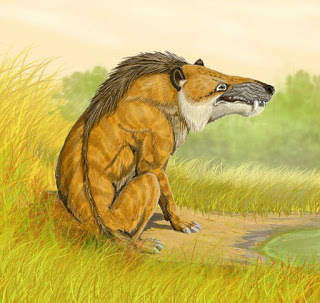 Possible appearance in life of Andrewsarchus mongoliensis (public domain)
Possible appearance in life of Andrewsarchus mongoliensis (public domain)Known only from a single fossil skull unearthed at a Gobi Desert site in 1923, but which measured a colossal 32.8 in long and 22 in wide, if this monstrous mammal were proportioned in the same manner as typical mesonychians, it would have attained an estimated total length of around 11 ft. However, although long deemed to have been a mesonychian, it has recently been reclassified by many palaeontologists as a carnivorous artiodactyl (even-toed ungulate) instead.
Nevertheless, it goes without saying, surely, that if an Andrewsarchus lineage, even one of smaller body stature than its original Mongolian antecedent, were surviving somewhere in the French countryside, its presence there would certainly not have gone unnoticed during all of the centuries preceding and following the Beast of Gévaudan's triennium of tyranny.
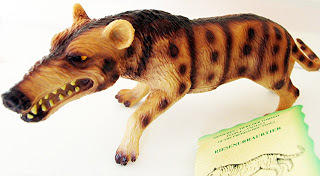 My German figurine model of Andrewsarchus
My German figurine model of AndrewsarchusThe same also applies in relation to the theory put forward by Pascal Cazottes in his book La Bête du Gévaudan: Enfin Démasquées? (2004), that the Beast was a surviving species of Hemicyon – a member of the prehistoric dog-bear or hemicyonid family of carnivorans (not to be confused with the prehistoric bear-dog or amphicyonid family of carnivorans) that flourished for between 17 to 11 million years during the Miocene epoch before dying out at its close, approximately 5.3 million years ago. Sporting tiger-like proportions and a somewhat ursine form but a dog-like dentition, it also ran in a digitigrade manner like dogs, rather than plantigrade like bears. Whether it would have resembled the Beast of Gévaudan, however, is another matter entirely.
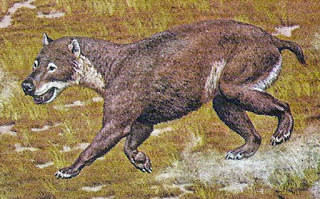 A restoration of Hemicyon (public domain)
A restoration of Hemicyon (public domain)In any case, during summer 1997 taxidermist Franz Jullien from France's National Museum of Natural History in Paris showed that the story of the second Beast's carcase having been buried was untrue (as was the claim that it sported hooves). For that was when he publicly announced his recent discovery in the museum of an old guide which sensationally revealed that this specimen had actually been exhibited there until at least 1819 (what happened to it afterwards, however, is unknown), and that during this time it had been conclusively identified – as a striped hyaena! Interestingly, a hyaena had long been favoured in the Gévaudan area as an identity for its nightmarish Beast, and could explain anecdotal accounts of its laughing cry, its large head, and hind limbs larger than forelimbs, but until now there had been no firm evidence to support it. Jullien published details of his significant find in the August 1998 issue of the journal Annales du Muséum du Havre.
As this particular hyaena species, Hyaena hyaena, is native to Africa and Asia but not to Europe, it was evidently an escapee or deliberate release from captivity - and it is a nothing if not interesting coincidence that Antoine Chastel, one of the two sons of hunter Jean Chastel who killed this second Beast, allegedly possessed a striped hyaena in his personal menagerie. According to a variation upon this claim, Antoine worked as a caretaker in the menagerie of exotic animals owned by a local aristocrat, the Count of Morangiès. Either way, however, there would seem to be a tenable origin for a striped hyaena on the loose in this specific region of France at the time of the Beast's onslaughts.
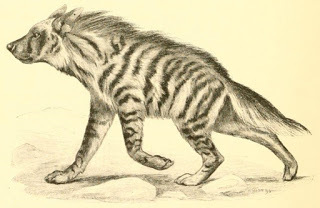 Sketch of a striped hyaena (public domain)
Sketch of a striped hyaena (public domain)The fundamental problem here is that normally the striped hyaena is a scavenger, not an active hunter, but perhaps a rogue or rabid individual might be, or one that had been deliberately trained to attack and kill people – see later here. Also worth noting is that only hyaenas have the jaw strength to bite clean through bones (their bite force even exceeds that of lions), and thereby perform the decapitations and limb shearings ascribed to the Beast; wolves cannot normally do this. Of course, hyaenas have fewer teeth (only 34) than the 40 claimed for the first shot Beast, but as this latter animal seems very likely to have been a wolf or wolf-dog hybrid (there does not appear to have been any suggestion that this too was a hyaena), that discrepancy is not a problem.
A hyaena trained to kill (by Jean Chastel, no less – see later for much more regarding this line of speculation) was the Beast identity favoured by cryptozoologist Ken Gerhard, investigating the Beast of Gévaudan saga alongside criminal profiler George Deuchar in an episode of the History Alive television documentary series entitled 'The Real Wolfman', which was screened by the History Channel in October 2009. However, the species put forward here was Africa's little-known brown hyaena H. brunnea, which seems a somewhat unlikely creature to have been held in captivity in 18th-Century rural France, and is not as potentially savage as the larger striped and (especially) spotted hyaena species anyway. So I'm unsure why the programme's 'powers-that-be' decided that this species should be the one for Ken and George's investigations to focus upon, rather than either of the other two hyaenas. Having said that, however, the programme made compelling viewing, with Ken readily demonstrating his cryptozoological acumen.
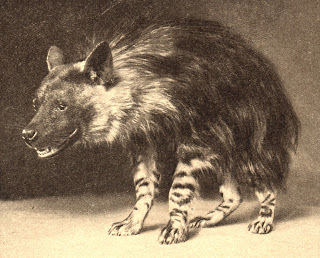 Early vintage photograph of a captive brown hyaena (public domain)
Early vintage photograph of a captive brown hyaena (public domain)In his extensive study of this saga, Monsters of the Gévaudan: The Making of a Beast (2011), University of North Carolina historian Prof. Jay M. Smith concluded that the Beast attacks were the collective activity of several different creatures, all of which were wolves, and that much of the terror gripping this region of France at the time had resulted from the way in which the saga was presented in the media, so that it was as much a social, cultural phenomenon as a cryptozoological one. Yet even if the latter aspect were true, as noted above wolves alone would be unlikely to achieve the bone-shearing massacres accomplished by the Beast.
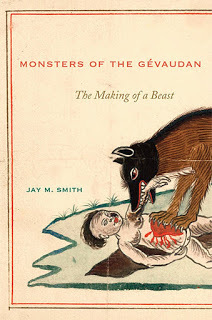 Monsters of the Gévaudan: The Making of a Beast
(© Prof. Jay M. Smith/Harvard University Press)
Monsters of the Gévaudan: The Making of a Beast
(© Prof. Jay M. Smith/Harvard University Press)Whatever its identity, however, the Beast of Gévaudan is by no means unique in the annals of French history, as the following selection of examples amply demonstrates, featuring some notorious episodes of lupine aggression.
Back in 1632, a bloodthirsty precursor to the Beast of Gévaudan allegedly frequented the Forest of Cinglais, from which it would periodically emerge to attack and kill people inhabiting a same-named village nearby (it was blamed for the deaths of over 30 people). The village of Cinglais was situated three miles south from the city of Caen, capital of Lower Normandy in northwestern France. During a gigantic hunt beat held in June 1633 and featuring 5000-6000 male participants, however, a large and very swift, agile animal subsequently identified as a wolf but with red fur was shot dead, after which the killings ceased.
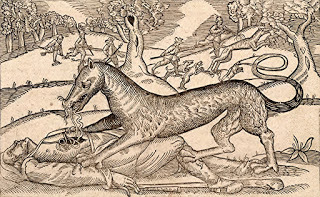 Engraving of the Beast of Cinglais (public domain)
Engraving of the Beast of Cinglais (public domain)Reports of marauding wild animals believed but never conclusively confirmed to be wolves have also emerged from many parts of France in the centuries that followed the demise of the Gévaudan-based Beast phenomenon (even though the wolf is nowadays virtually extinct in this country). As discussed by Véronique Campion-Vincent within an article from 1992 in the journal Folklore, explanations proffered by the authorities, the general public, wildlife experts, and investigators of specific cases have varied greatly - from natural migration or covert, human-engineered introduction of wolves into France from bordering countries; and deliberate release of captive specimens purposefully to kill farm creatures, or simply because they were no longer wanted by their erstwhile owners; to the accidental escape of menagerie and circus specimens, or exotic pet wolves maintained in private homes.
Thus, when two wolves were shot in a scarcely-populated pine forest in South-West Landes during 1968, investigators speculated that they may have been deliberately (but unofficially) introduced there from outside France by person(s) unknown. Deliberate release was a popular explanation for the presence of two wolves not far from Paris during 1972 - one of these was killed following a serious spate of livestock kills in the area. Two of the most notorious 20th Century cases on record, however, are those featuring the Beast of Cezallier and the Vosges Beast.
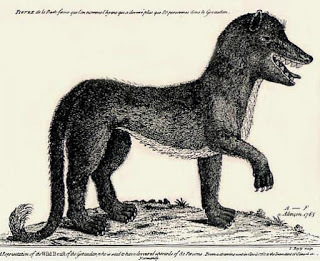 One of the most famous 18th-Century depictions of the first Gévaudan Beast (public domain)
One of the most famous 18th-Century depictions of the first Gévaudan Beast (public domain)During the 1940s, outbreaks of sheep slaughter in the environs of Cezallier, central France, regularly hit the newspaper headlines, inciting very appreciable discussion and dispute regarding the likely perpetrator of these killings - due in no small way to the remarkable variety of descriptions recorded for the alleged creature(s) in question. According to some eyewitnesses, the infamous Beast of Cezallier was definitely some type of big cat, variously resembling a lioness or a panther; others, conversely, were adamant that it was not feline but canine in form - undoubtedly a wolf or a very large feral dog.
The controversy continued throughout the 1940s and seemed set to do the same in the 1950s - until 1951, that is, when a bona fide wolf was shot near Grandrieu in the Upper Loire region, and the killings stopped. The dead wolf was duly dubbed the Beast of Cezallier, and the mystery was deemed officially solved - but it seems rather unlikely that eyewitnesses could confuse a creature so overtly dog-like in form as a wolf with lionesses or panthers. Quite probably, the wolf was only one of several culprits collectively responsible for the heinous deeds of the Cezallier Beast.
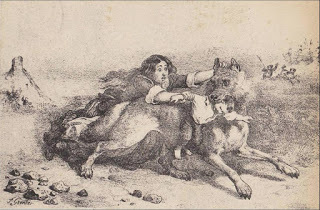 A graphic illustration of the Gévaudan Beast's predilection for attacking children (public domain)
A graphic illustration of the Gévaudan Beast's predilection for attacking children (public domain)History repeated itself during the late 1970s, but this time in the vicinity of Vosges, which experienced a near-epidemic of livestock killings, beginning on the Lorraine plateau near Rambervilliers, but progressing with the passing months to the Bresse highlands, and involving a horrific tally of death encompassing 31 different farms and collectively featuring more than 300 slaughtered or wounded sheep, three cows, a foal, and four dogs. Numerous organised hunts and searches were instigated, but their mysterious quarry eluded all of them. Then, after months of fruitless pursuit but regular Beast-blamed deaths, the killings suddenly ceased. The Beast was gone - or at least its blood-lust had been quelled - for it was never heard of again, and sheep could graze safely once more in the farmlands of Vosges.
Yet however disturbing the mystery attackers of Vosges and Cezallier may seem, we must remember that their victims had been sheep and other animal livestock, not humans. As a consequence, some researchers feel that there was far more to the homicidal Gévaudan Beast than an assortment of ravaging (even rabid?) wolves. In Africa, gruesome murders have been committed by the infamous leopard-man cults - secret societies who perform their terrible crimes masquerading as leopards, slashing their victims after the fashion of these great feline killing machines. Might something analogous have occurred in Gévaudan?
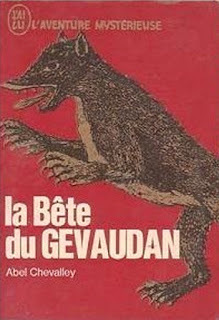 Abel Chevalley's novel (public domain)
Abel Chevalley's novel (public domain)The plot of French fiction writer Abel Chevalley's famous novel La Bête du Gévaudan (1936), inspired by the Gévaudan saga, yielded a lurid, highly imaginative scenario in which Antoine Chastel was an embittered, castrated sadist who lived apart from everyone else in Gévaudan, breeding monstrous hybrid hounds, one of which he then trained specifically to attack people, and that this was the Beast.. Yet so seductive and compelling was this overblown storyline that speculative, wholly-sensationalised fiction subsequently translated into speculative, but ostensibly-sober non-fiction, because it went on to influence several chroniclers of the real Beast saga,
Thus it was, for instance, that in his classic study La Bête du Gévaudan (1976), Gérald Ménatory promoted the possibility that much of the Gévaudan carnage was the work of one or more human serial killers - capitalising upon genuine Beast-engendered deaths to wreak their own murderous mayhem in secure anonymity – and concentrating in particular upon the idea that Antoine Chastel utilised a pet hyaena in nefarious activity of this kind.
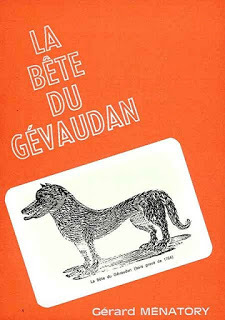 Gérald Ménatory's book La Bête du Gévaudan (© Imprimerie Chaptal et Fils)
Gérald Ménatory's book La Bête du Gévaudan (© Imprimerie Chaptal et Fils)The following year, in September 1977, a comprehensive 12-page article devoted to the 'human sadist' theory for the Gévaudan Beast appearing in monthly French magazine Historia. And during the mid-1980s, veteran French cryptozoologist Dr Bernard Heuvelmans, a disciple of Ménatory's theory, stated that he had no doubt that it was the correct explanation for the Gévaudan Beast's crimes. This disturbing notion and variations upon it have attracted considerable interest in more recent times too.
 The Beast makes the cover of the September 1977 issue of Historia (© Historia)
The Beast makes the cover of the September 1977 issue of Historia (© Historia)In 2004, the Australian-made TV documentary series Animal X (which examined a wide range of cryptozoological subjects) screened an episode devoted to the Beast entitled 'Monster or Murderer'. In it, the identity that was put forward once again echoed Chevalley's scenario, inasmuch as the Beast was perceived to have been a trained wolf-dog assailant.
A version of Ménatory's theory resurfaced in 2009, featuring the Beast as Antoine Chastel's hyaena, specifically trained by him or his father to attack people in order to cover up their family's sadistic serial killer activity. This, the theory argued, would thereby explain how Jean Chastel was able to shoot the second, hyaena-identified Beast so easily – i.e. after emerging slowly from a thicket, it neither attacked nor ran from him because it knew and trusted him.
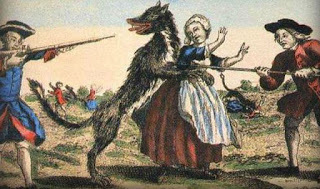 A 18th-Century French depiction of one of the Beasts in which it resembles a wolf-dog hybrid, as indicated by its white ventral stripe and very long tail (public domain)
A 18th-Century French depiction of one of the Beasts in which it resembles a wolf-dog hybrid, as indicated by its white ventral stripe and very long tail (public domain)There is no doubt that the Chastel family had a bad reputation in the Gévaudan area at the time of the Beast killings, with Jean Chastel viewed by suspicious locals as a witchcraft-practising hermit and Antoine whispered to be a lycanthrope (see below), but was their reputation for dark deeds justified? In his several Beast publications, modern-day French author Guy Crouzet emphatically declares that wolves were solely responsible, rejecting any involvement of the Chastels. On the contrary, he claims that because of their eccentric, reclusive lifestyle, the family had been used by the authorities as convenient scapegoats for the Beast's activities, destroying their reputation in the certain knowledge that they lacked the power or political clout to retaliate.
A noteworthy variation upon this theory postulates that Jean Chastel was definitely innocent of the witchcraft/serial killing claims, but that he purposefully trained some powerful, potentially ferocious creature to be a homicidal monster in order to revenge himself upon his reputation-blackening neighbours, priests, and the world at large.
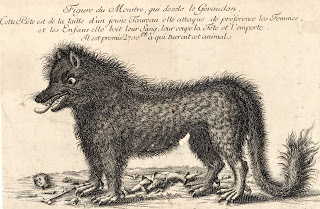 18th-Century depiction of an inordinately woolly-fleeced Beast - a veritable wolf in sheep's clothing! (public domain)
18th-Century depiction of an inordinately woolly-fleeced Beast - a veritable wolf in sheep's clothing! (public domain)Then again, it is nothing if not intriguing to note that during the search for the Beast by François Antoine and his party back in 1765, one of his men almost met his death in some marshes due to a malign prank played upon him by none other than Jean Chastel, Antoine Chastel, and Antoine's brother. As a result, François Antoine ensured that all three Chastels were imprisoned.
So there was definitely Beast-engendered bad feeling among the Chastels, thus making it all the more ironic (or suspicious?) that of all people it should be Jean Chastel who shot the second Beast in 1767. Could it be, therefore, that the first Beast killed was the real Beast of Gévaudan, and that the second one, the hyaena, was trained and released specifically by the Chastels to rampage and cause mayhem and hysteria as their revenge for their treatment by the first Beast's hunters?
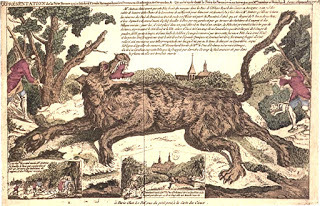 Another 18th-Century depiction of an unequivocally canine Beast being shot by François Antoine and his men (public domain)
Another 18th-Century depiction of an unequivocally canine Beast being shot by François Antoine and his men (public domain)Developing further this Chevalley-inspired theory of Chastel culpability in the Beast events, Jean Chastel is claimed by some modern-day investigators as quite possibly not only having trained but also having actually created the original Beast.
In his book La Bête du Gévaudan: L’Innocence des Loups (2000), French naturalist Michel Louis proposed that the Beast's supposed red pelage was the result of its having been sired by a red-furred mastiff (a dogue de Bordeaux?) owned at that time by Chastel, who allegedly mated the mastiff with a female wolf to create a vicious slaughtering monster. Such a hybrid would be an exceedingly formidable (and morphologically bizarre) beast, certainly – more than enough, in fact, to confuse and terrify anyone who encountered it.
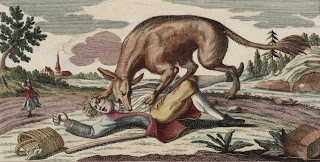 An 18th-Century depiction of the Beast portraying it with reddish pelage (public domain)
An 18th-Century depiction of the Beast portraying it with reddish pelage (public domain)A different take on the human killer theory was offered in a June 1980 Science et Viearticle by French cryptozoologist Jean-Jacques Barloy. Mindful of the intense rivalry existing between Protestants and Catholics amid the rural Gévaudan area at the time of the Beast killings, he suggested that perhaps those occurring after the first Beast was shot were caused by Protestants releasing huge dogs and/or a hyaena upon the Catholic peasantry there.
Yet another variation upon the human-based theory, as espoused in Loups Garous en Gévaudan – Le Martyre des Innocents (1995) by Pierre Cubizolles, is that one or more human sadists were indeed involved, and may even have donned wolf-skin costumes during their heinous actions, but belonged to the more elevated, aristocratic strata of society, and thus received protection and immunity from the authorities.
Certain other investigators, however, favour an even more chilling explanation. They propose that the Beast of Gévaudan was not merely a man in a wolf costume, but a bona fide loup-garou - a werewolf, committing its dreadful acts as a wolf, then transforming back into a man to avoid detection, with its identity quite possibly being that of Antoine Chastel, thereby meaning that neither of the shot creatures was the true Beast.
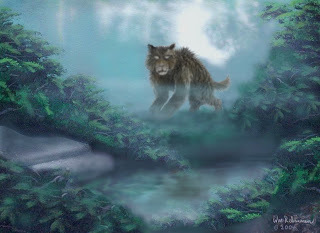 The Beast of Gévaudan – wolf, or wolf-man? (© William M. Rebsamen)
The Beast of Gévaudan – wolf, or wolf-man? (© William M. Rebsamen)Worthy of especial note in relation to this unsettling concept is the extraordinary encounter allegedly experienced in late August 1764, by a peasant woman from the village of Langogne in the Gévaudan district. According to her testimony as chronicled in various media reports from that time (how accurately, however, is another matter entirely!), while accompanied by her cattle and dogs she had come upon a bizarre entity as big as a donkey, clothed in short reddish hair, sporting a long tail, short ears, and pig-like snout, but which walked on its hind legs like a man! Fortunately for her, however, it had been warded off by the cattle, which confronted it with sharp horns at the ready after it had succeeded in scaring away the dogs.
It hardly needs stating that science views a wolf-man identity for the Beast of Gévaudan with great scepticism. In any case, straightforward non-transforming wolves/hyaenas or human sadists (or both) could certainly accomplish the Beast's horrific deeds, without the need for any lycanthropic intervention.
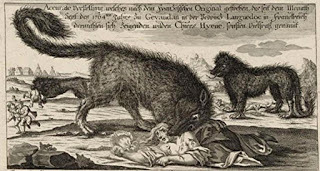 Three depictions of the Beast as a very hirsute, almost leonine creature (especially in the left-hand background representation) (public domain)
Three depictions of the Beast as a very hirsute, almost leonine creature (especially in the left-hand background representation) (public domain)So what wasthe Beast of Gévaudan? Perhaps I should rephrase that question: what were – or even who were – the Beasts of Gévaudan? For there seems little doubt that more than one entity was involved here, and I don't just mean the two beasts shot respectively by François Antoine's party in September 1765 (either a wolf or wolf-dog hybrid) and by Jean Chastel in June 1767 (apparently a striped hyaena, judging from the museum's identification of it). To kill the numbers of people recorded during the Beast's three years of savage bloodshed would require several wolves at least, plus the hyaena, and the possibility that the Chastels were complicit in some form of murderous spree cannot be ruled out either.
Consequently, as is so often apparent in the more involved cryptozoological cases, a composite explanation seems the most (indeed, the only) plausible one, cloaked in this instance by religious fear and ignorance, and conceivably fuelled by some degree of human evil too – not to mention a rampant, highly sensationalised media coverage, as evidenced by various of the overwrought contemporary illustrations from that coverage purposefully included in this present ShukerNature blog article, plus the bizarre media reports of the pig-snouted biped from August 1764.
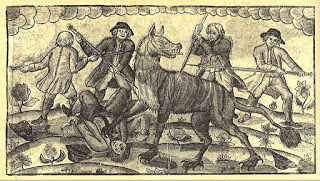 18thCentury portrayal of the first Beast as a somewhat unnerving pig-snouted, tuft-tailed quadruped with white chest (public domain)
18thCentury portrayal of the first Beast as a somewhat unnerving pig-snouted, tuft-tailed quadruped with white chest (public domain)The real Beast, therefore, or at least a component of it, may indeed have been humanoid, and bipedal, but it was not a werewolf; instead, it just might have been one or more humans acting in a truly bestial manner, with beasts of the four-legged variety taking the blame for their vile, inhuman activities – although we will probably never know for certain.
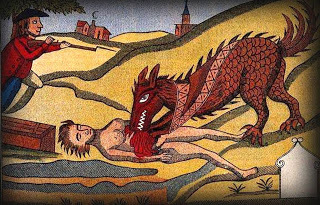 A scaly, inexplicably dragon-like Gévaudan Beast! (public domain)
A scaly, inexplicably dragon-like Gévaudan Beast! (public domain)All that we can say for sure is that truth may indeed be stranger than fiction sometimes, but very often it can be a lot more complex too.
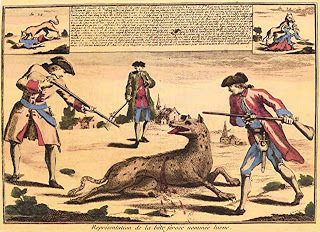 Dispatching the first Beast (public domain)
Dispatching the first Beast (public domain)The Beast of Gévaudan has been the subject of over 30 French non-fiction books and numerous novels, not to mention works in other languages too – click here and here to see selections of these varied publications.
This ShukerNature post is excerpted from my book-in-progress Dogs of Magic, Mythology, and Mystery – a canine companion to my earlier book Cats of Magic, Mythology, and Mystery .
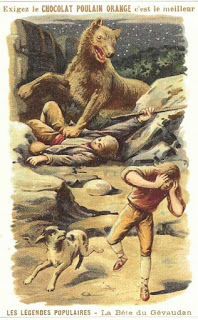 The Beast of Gévaudan, from Chastel to chocolate bar! (public domain)
The Beast of Gévaudan, from Chastel to chocolate bar! (public domain)
Published on August 21, 2015 16:25
August 19, 2015
FAN-TAILED MERMEN AND SCALY SEA BISHOPS
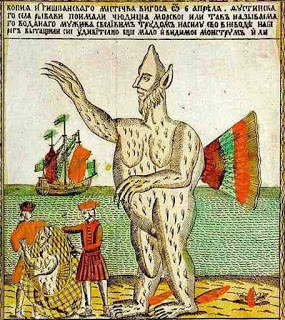 The version of the Russian merman-depicting lubok that was sent to me by Robert Schneck (public domain)
The version of the Russian merman-depicting lubok that was sent to me by Robert Schneck (public domain)On 18 August 2015, Facebook friend Robert Schneck kindly brought to my attention on my FB timeline a fascinating illustration that I had never seen before, and which opens this current ShukerNature blog article. As far as I am aware, it has not previously attracted any notable cryptozoological attention, so I've been conducting some investigations into it, whose findings I am now presenting here as follows.
The illustration is a Russian lubok, which, to quote from the Wikipedia entry for such images, is:
"…a Russian popular print, characterized by simple graphics and narratives derived from literature, religious stories and popular tales. Lubki prints were used as decoration in houses and inns. Early examples from the late 17th and early 18th centuries were woodcuts, then engravings or etchings were typical, and from the mid-19th century lithography…Folklorist Dmitri Rovinsky is known for his work with categorizing lubok. His system is very detailed and extensive, and his main categories are as follows: "icons and Gospel illustrations; the virtues and evils of women; teaching, alphabets, and numbers; calendars and almanacs; light reading; novels, folktales, and hero legends; stories of the Passion of Christ, the Last Judgement, and sufferings of the martyrs; popular recreation including Maslenitsa festivities, puppet comedies, drunkenness, music, dancing, and theatricals; jokes and satires related to Ivan the Terrible and Peter I; satires adopted from foreign sources; folk prayers; and government sponsored pictorial information sheets, including proclamations and news items". Jewish examples exist as well, mostly from Ukraine. Many luboks can be classified into multiple categories."
The lubok under discussion here shows what appears to be some form of merman-like entity (though with hind limbs instead of a single fish-tail) that had been netted at sea, but no doubt some details concerning this case were contained in the Cyrillic-script text included above the lubok's image. Seeking a translation of this text online, I came upon one on the Monster Brains website (click here ).
It stated that the merman lubok's text did indeed describe a strange aquatic humanoid, one which had been caught in Spain, and that the image had been created by an anonymous folk artist in 1739. What was particularly interesting, however, was that this site then provided not just a translation of the text, but also a version of the merman lubok that contained additional Cyrillic text underneath the image – text that was not present in the version that Robert had found and sent to me – thus explaining why the translation was so lengthy. So here is this more detailed version of the merman lubok:
 The version of the merman lubok containing additional text (public domain)
The version of the merman lubok containing additional text (public domain)Incidentally, the source of both the lubok with additional text and the translation of it as presented by Monster Brains was given by this latter site as http://www.rollins.edu/Foreign_Lang/Russian/Lubok/lubnews.html – but this page can no longer be found online. Meanwhile, here is the translation of the full text as provided by the Monster Brains website
"A copy [of the news] from the Spanish town of Vigo from the 6th of April. The fishermen of the village of Fustin (Enfesta?) caught a sea monster or the so-called water man and with great difficulty dragged him by force in the net ashore. This amazing and rarely seen monstrum or sea wonder is from head to foot about 6 feet tall. Its head resembles a stake and is so smooth that it does not have even one hair on the top, only at the bottom it has a beard with long strands. The skin on its head and on the whole body is black and in some places covered with thin hair. The neck of this water old man is extremely long and the body unusually long and thick but in many respects it resembles the human body. The forearms and arms are very short, the palms are quite short, while the fingers are very long and up to the first joint, like a goose's feet, they are grown together and from there they go like human fingers. Its extraordinarily long nails resemble animals' and even though this monstrosity has low hanging breasts, it is, by all indications, of masculine gender. Its loins are short and grown together to the knees, and the shins are not very long either, but they are separated. Even though its feet are quite similar to human, the large toes hang quite close to each other like duck's feet. On its heels it has fish's scales, and on the skin of its back at the very bottom a bone has grown. A fin sticking out from it is just like a woman's fan, about 12 inches long, and when it opens it reaches even more than 12 inches. This was excerpted from the printed St. Petersburg News, received on the 20th of May of this, 1739, year, and the above news were reported in the No. 41."
I subsequently found this same translation and version of the merman lubok on another site, The Hermitage (click here ), on Tumblr. It credits the translation to the same no-longer-available page source as did Monster Brains, but additionally names the translator himself as one Alexander Boguslawski, and dates his translation as being from the year 1999. (Incidentally, call me paranoid, but in view of the highly mysterious nature of the entity depicted in this particular lubok, I do wish that the translator's surname had not included 'Bogus' in it!)
As can be readily seen, both the verbal description and the visual depiction of this entity reveal an exceedingly bizarre being – one so bizarre, in fact, that it is difficult to know how to assess it. Could it be some grossly-deformed human, perhaps? Or might it be a sea creature of known species but whose form has been distorted out of all recognition by some woefully-inaccurate verbal description spawned by the Chinese whispers syndrome from source to documentation, and illustrated by someone who did not see the creature itself but was instead entirely reliant upon the mutilated verbal account resulting from the Chinese whispers syndrome? Or is it possible that it truly was some extraordinary entity of a type still unknown to science – a veritable merbeing?
Regarding the option of this alleged merman being a severely deformed human: its cone-shaped head might have been an indication of microcephaly, as exhibited by certain individuals on record who have been dubbed 'pinheads'; its scaly skin may have been a possible allusion to ichthyosis; and its conjoined loins to the knees is a trait of sirenomelia, the so-called mermaid syndrome. However, it would surely be very unlikely (as well as exceedingly unlucky and unfortunate) for any one person to exhibit all of these very different, congenitally unrelated, and morphologically extreme conditions.
In any case, the single most outstanding morphological feature described for this entity is without doubt its apparent tail fin, depicted as a very large, multi-coloured, fan-like structure and described in similar vein too. If that feature is genuine, and could indeed open and close as claimed in the description, then we can evidently eliminate a teratological human from further consideration, because I cannot envisage how any congenital condition, however extreme, could create a structure even vaguely reminiscent of this fin.
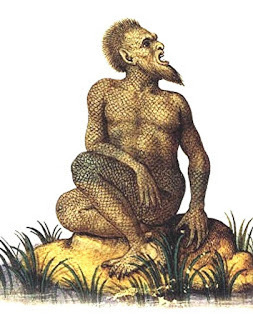 Another scaly merman-like entity with hind limbs, as documented in The Animal Book, written by famous Italian humanist and Renaissance author Pietro Candido Decembrio (1399-1477), commissioned by Ludovico Gonzaga, Marquis of Mantua, and published in 1460, with its illustrations added during the next century – click
here
for more anomalous entities featured in this book (public domain)
Another scaly merman-like entity with hind limbs, as documented in The Animal Book, written by famous Italian humanist and Renaissance author Pietro Candido Decembrio (1399-1477), commissioned by Ludovico Gonzaga, Marquis of Mantua, and published in 1460, with its illustrations added during the next century – click
here
for more anomalous entities featured in this book (public domain)Could the lubok have resulted from a much-distorted description of some known (but possibly not overly familiar?) sea beast? There is no doubt that the medieval and Renaissance bestiaries are full of grotesque illustrations of beasts known to modern-day science but not so familiar to layman observers back then. Yet even if so, it would surely require a truly massive stretch of the imagination and all but entirely unrestrained, unlimited powers of mis-description to yield a bipedal humanoid being with a conical cranium, four limbs, and a huge caudal tail fin from anything as zoologically mundane as a pinniped, cetacean, sirenian, or shark, for instance.
As for it constituting a bona fide merman: I have documented elsewhere on ShukerNature (click here ) some very intriguing cases of mysterious carcases that have been put forward at one time or another as evidence for the reality of merfolk, and which, if the descriptions of such carcases were accurate (none of them, tragically, was retained or scientifically examined), cannot be readily identified with any known marine life-forms. Consequently, although I freely admit that the reality of such entities is very remote, I am loathe to discount entirely the possible existence of some kind of specialised sea-dwelling mammal that bears a superficial resemblance to the fabled mermaids and mermen of classical legend.
Of course, there is also a fourth possible explanation, and which may well be the most plausible – namely, that the entire report was a journalistic hoax, or at the very least merely a relocated rehash of some earlier account from the annals of early natural history. In relation to this latter prospect, when he sent me the abridged version of the merman lubok Robert mentioned that the entity's pointed head reminded him of the sea bishop.
Lovers of bestiaries will be very familiar with this latter creature and its scaly-skinned image, which, in the tradition of bestiary and proto-encyclopaedia compilers for many centuries, has been reproduced with minor variations in numerous works dating from the mid-1500s onwards.
As far as I can tell, the sea bishop's earliest documentation was in French naturalist French Belon's work De Aquatilibus(1553), followed a year later by French marine biological researcher Guillaume Rondelet in his own tome Libri de Piscibus Marinis (1554), where he recorded a sighting of it from 1531 in the Baltic Sea off Poland by physician Gisbertus Germanus. Rondelet's work also contained an illustration of this sea bishop, but perhaps the most famous depiction of it appeared in 1558, as an engraving in the fourth volume of Swiss naturalist Conrad Gesner's monumental multi-volume, 4500-page Historia Animalium (1553-1558):
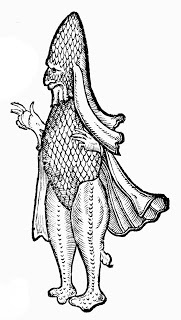 Engraving of the sea bishop, from Conrad Gesner's Historia Animalium (public domain)
Engraving of the sea bishop, from Conrad Gesner's Historia Animalium (public domain)This extraordinary sea monster was portrayed as a highly anthropomorphic humanoid-fish composite, and its sighting in 1531 was during Gesner's own lifetime (1516-1565). However, there is some confusion as to the creature's subsequent fate (not documented by Gesner).
Some sources state that it was captured alive and taken to the King of Poland, who wished to keep it, and was also shown to a group of Catholic bishops, to whom it gestured, appealing to be released, whereupon the bishops granted its wish and the creature in return made the sign of the Cross before disappearing back into the sea. (If nothing else, this is an interesting example not merely of ecclesiastical solidarity but also of the popular belief dating back as far as the time of Plato, 428/427 or 424/423 – 348/347 BC, that everything on land has a counterpart in the sea.) Other sources, conversely, document a sadder, less familiar end for the sea bishop, claiming it was actually caught off Germany, not Poland, and died in captivity three days later after refusing to eat (but I wonder if this story's differing location may originate from some confusion involving the name of its eyewitness, Gisbertus Germanus?).
Another well known version of the classic sea bishop illustration appeared in Johann Zahn's Specula Physico-Mathematico-Historica Notabilium ac Mirabilium Sciendorum (1696):
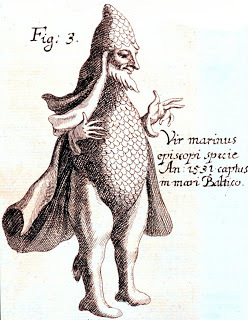 The sea bishop as depicted in Zahn's tome (public domain)
The sea bishop as depicted in Zahn's tome (public domain)There is no doubt that the Spanish merman portrayed in the Russian lubok is reminiscent of the Baltic sea bishop, especially if the latter's billowing fin-like cloak is equated with the merman's fan-like caudal fin:
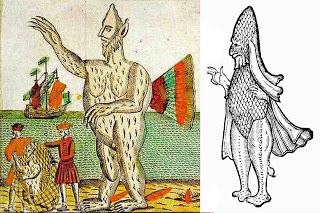 Spanish merman compared with Baltic sea bishop (public domain)
Spanish merman compared with Baltic sea bishop (public domain)So if the sea bishop may provide a precedent of sorts, or possibly even a direct source or inspiration, for the Spanish merman, what might the sea bishop itself have been?
In his magnum opus, Gesner had also included an engraving and description of another mysterious 'human fish', the so-called sea monk. Again, this had been previously documented by Rondelet in his Libri de Piscibus Marinis, and by Belon in De Aquatilibus, but it was Gesner's coverage of it that first brought this creature to widespread attention. Here is Gesner's engraving:
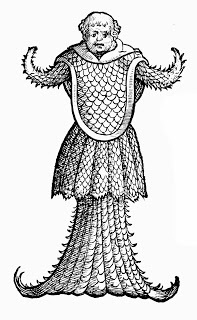 Engraving of the sea monk, from Conrad Gesner's Historia Animalium (public domain)
Engraving of the sea monk, from Conrad Gesner's Historia Animalium (public domain)This marine monster had allegedly been caught off Norway according to Gesner (or in the Øresund, the strait separating Sweden from the eastern coast of the large Danish island of Zealand, according to some other sources) in 1546, once again during Gesner's own lifetime, but its carcase was not retained; instead it was swiftly buried as an abomination on the orders of the Danish king, Christian IIII. In subsequent centuries, however, it has attracted (and still attracts today) considerable interest and controversy as to what it may have been.
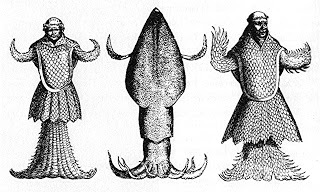 Japetus Steenstrup's comparison of two versions of the sea monk engraving with, at centre, a giant squid (public domain)
Japetus Steenstrup's comparison of two versions of the sea monk engraving with, at centre, a giant squid (public domain)Identities that have been proffered by various researchers include a giant squid (by 19th-Century Danish zoologist Japetus Steenstrup and more recently by giant squid chronicler Richard Ellis), an angel shark Squatina squatina (a large, dorsoventrally flattened species commonly dubbed a monkfish after its superficially monk-like form, proposed in 2005 by St Andrews University ecologist/mathematician Dr Charles Paxton and co-researcher R. Holland), a walrus (by veteran cryptozoologist Dr Bernard Heuvelmans), and various species of phocid seal.
Yet whereas I can see points in favour for each of the above creatures as identity contenders for the sea monk, I can see none for any of them as identity contenders for the sea bishop.
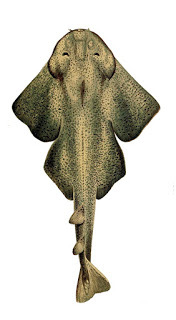 The angel shark or monkfish Squatina squatina, vintage illustration from 1877 (public domain)
The angel shark or monkfish Squatina squatina, vintage illustration from 1877 (public domain) As with the sea monk, I have encountered various attempts to reconcile the sea bishop with some form of squid. Yet even if we equate the sea bishop's markedly pointed head with the pointed rear portion of a squid's body, its two hefty-thighed legs are a poor substitute for the ten long slender arms and tentacles of a squid – unless we can envisage a squid whose eight shorter arms are united and obscured within some form of web-like interconnecting membrane, thereby explaining the bishop's cloak, with the latter's two legs being the longer prey-capturing tentacles of the squid?
Alternatively, bearing in mind that it was meant to be a sea bishop, might this creature's very pointed head have simply been an exaggerated (or even a completely fabricated) description, in order to provide it with an equivalent of sorts to a real bishop's mitre? It's all very tenuous, to say the least, and offers even less likelihood as a reasonable explanation for the Spanish merman with its caudal fanned fin.
In an interesting Folklore journal paper from 1975, W.M.S. Russell and F.S. Russell proposed that the sea bishop may actually have been a skilfully executed gaff along the lines of the Jenny Haniver. In their paper, they revealed how they had actually created a couple of Jenny Hanivers in the form of sea bishops, using two small alcohol-preserved specimens of the thornback skate Raja clavata.
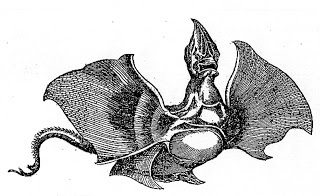 A much-reproduced engraving of a Jenny Haniver, from Ulisee Aldrovandi's tome Monstrorum Historia (1642) (public domain)
A much-reproduced engraving of a Jenny Haniver, from Ulisee Aldrovandi's tome Monstrorum Historia (1642) (public domain)For now, however, in the absence of any tangible evidence for their identities, both the sea bishop engraving and the Russian lubok's Spanish merman remain pictorial enigmas, which may bear little if any resemblance to the original creature(s) that they depict – always assuming of course that any such creature ever existed to begin with!
I plan to pursue the Spanish merman now via a different route, investigating whether other, preferably Spanish reports of its alleged capture exist – any discoveries will be included here as updates.
My sincere thanks to Robert Schneck for kindly bringing the Russsian merman lubok to my attention.
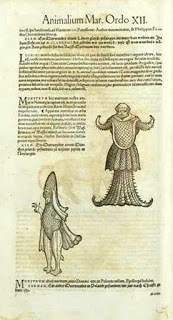 Sea monk and sea bishop sharing a page in Conrad Gesner's Historia Animalium (public domain)
Sea monk and sea bishop sharing a page in Conrad Gesner's Historia Animalium (public domain)
Published on August 19, 2015 14:50
August 14, 2015
MEDIEVAL SNAIL-CATS IN ILLUMINATED MANUSCRIPTS - OR, CURIOUS CRITTERS FROM THE MENAGERIE OF MARGINALIA
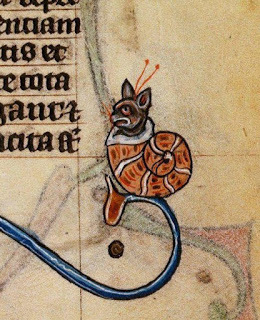 A snail-cat, depicted in the Maastricht Hours – an illuminated devotional manuscript produced in the Netherlands during the early 1300s (public domain)
A snail-cat, depicted in the Maastricht Hours – an illuminated devotional manuscript produced in the Netherlands during the early 1300s (public domain)After my exhaustive books Mystery Cats of the World (1989) and Cats of Magic, Mythology, and Mystery (2012) were published, I might have been forgiven for thinking that I must surely have documented a representative selection of examples for every anomalous feline form ever recorded – but I would have been wrong, as now revealed here.

The vast assembly of curious creatures inhabiting the exquisite world wrought by generations of medieval monks and lay artists laboriously creating illuminated manuscripts of religious tracts and other devotional works is like none other anywhere in the history of zoological artwork. Alongside such stalwarts of classical Western mythology as dragons, unicorns, griffins, wildmen, and demons are all manner of truly bizarre entities that are commonly termed grotesques, for good reason. Impossible hybrids, crossbreeds, and composites of every conceivable (and inconceivable!) combination, they exhibit a surreal 'mix 'n' match' approach to morphology, deftly and effortlessly uniting the head(s) of one species with the limbs of a second, the wings of a third, and the body of who knows what from who knows where. In cases where these grotesques are more comical than frightening in form, however, they are generally referred to as drolleries.
As mentioned in previous ShukerNature blog articles and other publications of mine, I've always been especially interested in the more unusual contingent of animal life –real, imaginary, and those somewhere in between (I believe the term that I'm looking for here is cryptozoology!). Consequently, it should come as no surprise to learn that this marginalia menagerie, i.e. the zoological monsters and monstrosities lurking amid the margins (and sometimes cavorting among the illuminated letters too) of medieval manuscripts, have long held a particular fascination for me, and I have spent many long but very pleasant hours scrutinising examples from these sources as depicted in books, articles, and online, as well as sometimes directly examining such manuscripts themselves, thus embarking upon an entertaining if unequivocally esoteric safari seeking cryptic creatures of the decidedly uncommon and uncanny kind.
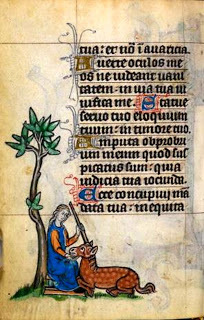 A virginal maiden attended by a spotted unicorn, depicted in the Maastricht Hours (public domain)
A virginal maiden attended by a spotted unicorn, depicted in the Maastricht Hours (public domain)Thus it was that I was recently delighted to encounter not one but three different examples of a particular mini-monster of the marginalia variety that I had never previously spotted within the medieval manuscripts' sequestered yet richly ornate realm of emblazoned folios and ornamented parchment. Moreover, unlike so many others sharing its domain, this creature exhibited a well-defined, memorable – even quaint – form, an engaging little drollery combining the whorled shell of a snail with a cat's emerging head and neck (sometimes its front paws too). And so, gentle reader, without further ado I give you the snail-cat – or, should you prefer it, the cat-snail.
(Incidentally, as will be revealed later here, the artistic motif of animals housed in snail shells is by no means confined to cats. On the contrary, so many variations upon this molluscan theme are on record, including humans as well as animals, that these entities even have their very own term – malacomorphs, which translates as 'shell forms'.)
Back to the snail-cats: out of this current trio of molluscan moggies (or feline malacomorphs, to employ the more technical moniker for such incongruous crossbreeds), the first one to come to my attention did so while I was browsing through the British Library's online digital version (click here ) of the Maastricht Hours – a sumptuously illustrated version of the once-popular book of hours. But what is a book of hours?
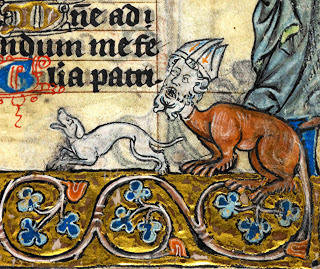 A manticore bishop with curlicue tail, from the Maastricht Hours (public domain)
A manticore bishop with curlicue tail, from the Maastricht Hours (public domain)Back in the 12th Century, the most common books owned by families in Europe wealthy enough to possess such items were psalters – which normally contained the 150 psalms of the Old Testament and a liturgical calendar. They were also beautifully illustrated by monks. Subsequently developed from the psalter was the breviary, which contained all the liturgical texts for the Office (aka the canonical prayers), whether said in choir or in private. During the 14thCentury, however, books of hours appeared on the scene. A type of prayer book designed for laypeople, they largely eclipsed psalters and breviaries, and whereas these latter works had been illuminated predominantly by monks (monasteries being the principal producers of books back then), books of hours could be commissioned by the wealthy from professional scribes and lay-owned illuminators in towns and cities, and many of these beautiful works still survive today. Here is Wikipedia's definition of the book of hours:
The book of hours is a Christian devotional book popular in the Middle Ages. It is the most common type of surviving medieval illuminated manuscript. Like every manuscript, each manuscript book of hours is unique in one way or another, but most contain a similar collection of texts, prayers and psalms, often with appropriate decorations, for Christian devotion. Illumination or decoration is minimal in many examples, often restricted to decorated capital letters at the start of psalms and other prayers, but books made for wealthy patrons may be extremely lavish, with full-page miniatures.
Books of hours were usually written in Latin (the Latin name for them is horae), although there are many entirely or partially written in vernacular European languages, especially Dutch. The English term primer is usually now reserved for those books written in English. Tens of thousands of books of hours have survived to the present day, in libraries and private collections throughout the world.
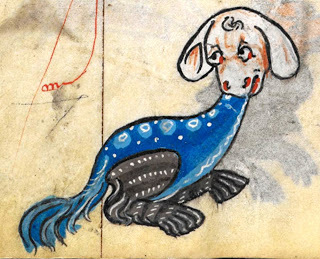 Unidentified creature in the Maastricht Hours (public domain)
Unidentified creature in the Maastricht Hours (public domain)The typical book of hours is an abbreviated form of the breviary which contained the Divine Office recited in monasteries. It was developed for lay people who wished to incorporate elements of monasticism into their devotional life. Reciting the hours typically centered upon the reading of a number of psalms and other prayers. A typical book of hours contains:
· A Calendar of Church feasts· An excerpt from each of the four gospels· The Little Office of the Blessed Virgin Mary· The fifteen Psalms of Degrees· The seven Penitential Psalms· A Litany of Saints· An Office for the Dead· The Hours of the Cross· Various other prayers
In its Catalogue of Illumination Manuscripts, the British Library lists the Maastricht Hours as MS [Manuscript] Stowe 17. Written in Latin (using Gothic script), but with a calendar and final prayers in French, it was produced during the first quarter of the 14th Century in Liège, the Netherlands, probably for a noblewoman, who may be represented as a kneeling female figure in several places throughout the manuscript. It is lavishly illustrated throughout, and its margins in particular are crammed with all manner of grotesque beasts and other figures, often engaged in bizarre, surprising forms of behaviour, especially so in view of their setting – a religious devotional book.
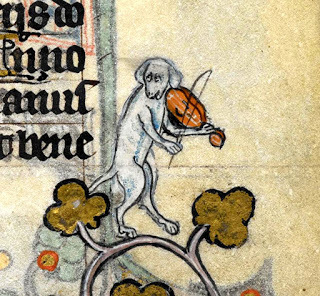 A fiddle-playing dog in the Maastricht Hours (public domain)
A fiddle-playing dog in the Maastricht Hours (public domain)Handsomely bound in blind-tooled blue leather, it was once owned by Richard Temple-Nugent-Brydges-Chandos-Grenville (1776-1839), 1st Duke of Buckingham and Chandos, who resided at Stowe House, near Buckingham in Buckinghamshire, England, where it formed part of the famous Stowe Library (hence its Stowe designation by the British Library). After a series of intervening changes of hand, however, it was finally purchased in 1883 by the British Museum, together with 1084 other Stowe manuscripts.
The Maastricht Hours consists of 273 folios. Like other manuscripts from the Middle Ages, it was bound without page numbers. In relation to such manuscripts, the term 'folio' (commonly abbreviated to 'fol' or simply 'f') is used in place of 'page', and the front or top side of each folio is referred to as the recto ('r'), with the back or under side of each folio being the verso ('v'). Consequently, as examples of how folios are designated in such manuscripts, the front side of a manuscript's fifth folio would be referred to as f 5r, and the back of the manuscript's 17thfolio as f 17v. Bearing in mind that some consist of as many as 300 folios or even more, illuminated manuscripts housed in libraries sometimes have the respective number of each constituent folio lightly pencilled upon its recto side's top-right corner, for ease of access to specific folios.
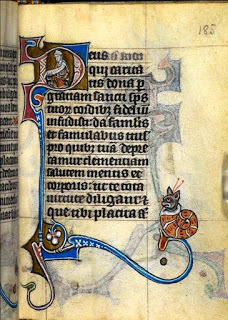 Folio 185 recto (f 185r) of the Maastricht Hours, depicting a scowling snail-cat (public domain)
Folio 185 recto (f 185r) of the Maastricht Hours, depicting a scowling snail-cat (public domain)On f 185r of the Maastricht Hours, which contains a prayer for the family of the book's owner, a scowling snail-cat is clearly visible, perched upon an illuminated curl sweeping underneath the prayer. Its shell is dextral in shape, i.e. its whorls spiral to the right, and disproving the opinion of some writers who have suggested that perhaps snail-cats depicted in medieval manuscripts are simply ordinary domestic cats sitting inside empty (albeit exceedingly large!) snail shells with their head and neck sticking out of the shell's aperture, this particular snail-cat confirms its bona fide hybrid nature by sporting a pair of antenna-like snail stalks on top of its head. Unlike those of real snails, however, its stalks do not bear eyes at their tips – its eyes being set in its face instead, like those of normal cats.
 Close-up of the Maastricht Hourssnail-cat (public domain)
Close-up of the Maastricht Hourssnail-cat (public domain)But this is not the only shelly surprise contained within this manuscript's folios. Several other entities of equally unexpected shell-bearing status can also be found here, as now shown.
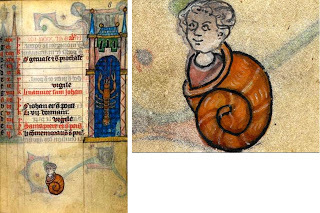 Snail-youth on f 8r and in close-up (public domain)
Snail-youth on f 8r and in close-up (public domain)The head and shoulders of a curly-headed youth(?) emerge from a sinistral shell (its whorls spiralling to the left) at the bottom of f 8r, as do those of an unidentified horned ungulate at the bottom of f 11r.
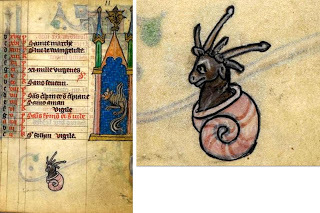 Enshelled unidentified ungulate on f 11r and in close-up (public domain)
Enshelled unidentified ungulate on f 11r and in close-up (public domain)A bearded dextral-shelled snail-man with emerging upper torso including arms can be seen at the bottom of f 193v:
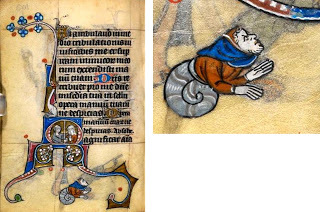 Snail-man on f 193v and in close-up (public domain)
Snail-man on f 193v and in close-up (public domain)A dextral-shelled snail-goat appears on f 222v:
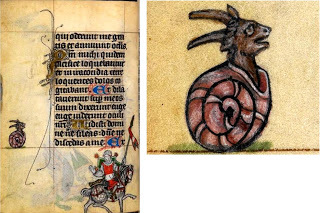 Snail-goat on f 222v and in close-up (public domain)
Snail-goat on f 222v and in close-up (public domain)And on f 272r a woman is shown dancing before a smaller dextral-shelled snail-human whose face has been obscured by wear and tear of the book down through the centuries.
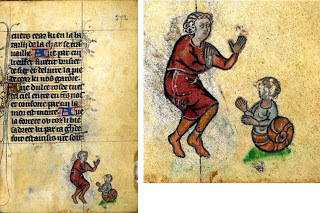 Woman dancing before smaller snail-human on f 272r and in close-up (public domain)
Woman dancing before smaller snail-human on f 272r and in close-up (public domain)Whoever produced the artwork for this manuscript evidently had a serious passion for manufacturing malacomorphs!
My second snail-cat turned up in the Bibliothèque Mazarine's MS 62, NT Épîtres de Saint Paul (originally the personal library of Cardinal Mazarin, the celebrated Italian cardinal and diplomat who served as Chief Minister to the French monarchy from 1642 until his death in 1661, the Bibliothèque Mazarine is the oldest public library in France). As its title suggests, this manuscript contains the Epistles of St Paul from the New Testament, written in the Vulgate Latin translation. It consists of 149 folios, dates from the final quarter of the 14th Century, and was originally owned by the Convent of the Minimes in the village of Nigeon, located on the hill of Chaillot, near Paris.
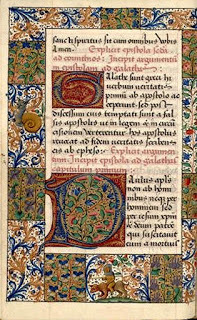 F 70v of the Bibliothèque Mazarine's MS 62, NT Épîtres de Saint Paul, revealing the presence of a snail-cat in the left-hand margin (public domain)
F 70v of the Bibliothèque Mazarine's MS 62, NT Épîtres de Saint Paul, revealing the presence of a snail-cat in the left-hand margin (public domain)On f 70v of this manuscript, one of the quadrants in the elaborately illuminated margin's left-hand side contains a delightful snail-cat, one that in sharp contrast to the distinctly unfriendly version in the Maastricht Hours is happily smiling, is housed within a sinistral snail shell, and is revealing its front paws. It lacks the snail horns of the Maastricht snail-cat, but its ears are unusually long and pointed.
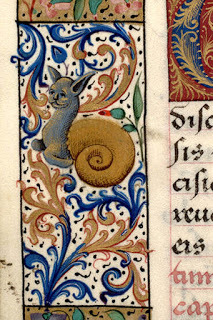 Close-up of the snail-cat in f 70v of the Bibliothèque Mazarine's MS 62, NT Épîtres de Saint Paul (public domain)
Close-up of the snail-cat in f 70v of the Bibliothèque Mazarine's MS 62, NT Épîtres de Saint Paul (public domain)As with the Maastricht Hours, moreover, its snail-cat is not the only malacomorph drollery present in this manuscript. Browsing through its complete collection of illuminated folios online (click here ), I also spotted a snail-griffin on f 89v whose shell is attached solely to its haunches, with the rest of its body entirely external to it; a bearded human-headed snail-monster on f 102v; and a strange dog-like snail-monster bearing what resembles a reverse coxcomb upon its head on f 112.
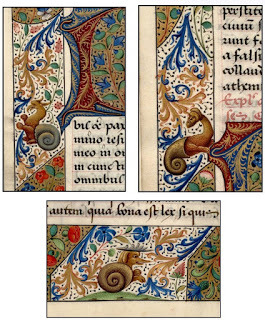 Snail-griffin (top left), human-headed snail-monster (top right), and dog-like coxcombed snail-monster (bottom), from the Bibliothèque Mazarine's MS 62, NT Épîtres de Saint Paul (public domain)
Snail-griffin (top left), human-headed snail-monster (top right), and dog-like coxcombed snail-monster (bottom), from the Bibliothèque Mazarine's MS 62, NT Épîtres de Saint Paul (public domain)Snail-cat #3 appears in a Paris-originating book of hours manuscript entitled Horae ad Usum Parisiensem, which dates from the final quarter of the 15th Century, consists of 190 folios plus four additional folios in parchment, and is written in Latin. It is held in the National Library of France's Department of Manuscripts, but can be viewed in its entirety online here .
Its snail-cat appears on f 187r, and like the previous example it is smiling with front paws present outside its shell, whose whorls spiral in a dextral configuration. Its ears are less pronounced and pointed than those of snail-cat #2, and it lacks the snail horns of snail-cat #1.
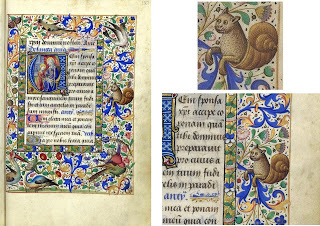 Snail-cat on f 187r and in two close-ups, from Horae ad Usum Parisiensem (public domain)
Snail-cat on f 187r and in two close-ups, from Horae ad Usum Parisiensem (public domain)Whereas the illuminator of the Maastricht Hoursexhibited a definite obsession with malacomorphs, the artist responsible for the marginalia menagerie in Horae ad Usum Parisiensem showed far more interest in composite centaurs, depicting a wide range of forms, but only one malacomorph other than the snail-cat. This second malacomorph is itself a composite, combining the turbaned head, arms, and upper torso of a man with a pair of large bat-like wings the lower torso and front paws of a leonine creature, and a sinistral snail shell; it appears on f 46r.
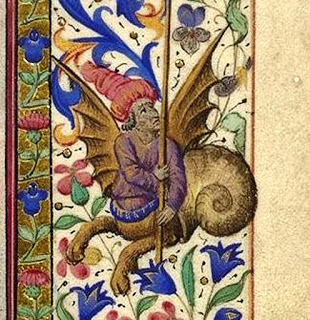 Composite malacomorph on f 46r from Horae ad Usum Parisiensem (public domain)
Composite malacomorph on f 46r from Horae ad Usum Parisiensem (public domain)During my browsing of various other illuminated manuscripts online in recent times, I've collected a number of additional malacomorphs, and a small selection of the more interesting and unusual ones is presented below.
An unidentified (possibly porcine?) but unequivocally angry malacomorph appears on f 109v of esteemed Flemish author-poet Jacob van Maerlant's manuscript Van Der Naturen Bloeme, produced in The Hague, Netherlands, in c 1350. This is in turn a free translation of 13th-Century Brabant author Thomas of Cantimpré's 20-volume magnum opus De Natura Rerum.
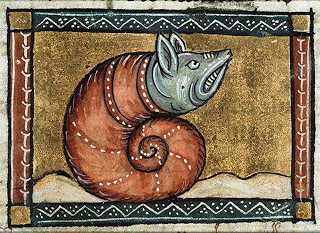 Jacob van Maerlant's angry malacomorph (public domain)
Jacob van Maerlant's angry malacomorph (public domain)The Luttrell Psalter is an illuminated manuscript produced sometime during 1325-1340 for the wealthy Luttrell family of Irnham in Lincolnshire, headed by Irnham's lord of the manor, Sir Geoffrey Luttrell, who commissioned its preparation. It consists of 309 folios, is written in Latin, and is now held in the British Library as Additional Manuscript (Add. MS) 42130, after having been acquired by the British Museum in 1929.
It is famous for its extraordinary array of truly monstrous marginalia grotesques, prepared by anonymous illuminators. Indeed, in her fascinating book Monsters and Grotesques in Medieval Manuscripts(2002), Alixe Bovey, a curator in the British Library's Department of Manuscripts, notes that the realistic scenes of daily life on a medieval estate such as owned by the Luttrells as portrayed in this psalter are interspersed with:
…creatures of such startling monstrosity that they prompted one scholar to comment that 'the mind of a man who could deliberately set himself to ornament a book with such subjects…can hardly have been normal'. While it seems unwise to use the margins of the Luttrell Psalter to diagnose the mental condition of its artists, there can be no doubt that the artist who illuminated many of its pages had an exceptionally fertile imagination.
Indeed he did, and as proof of that, here is a noteworthy avian malacomorph that appears on f 171v of the Luttrell Psalter:
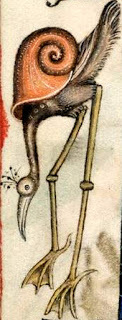 Avian malacomorph from the Luttrell Psalter (public domain)
Avian malacomorph from the Luttrell Psalter (public domain)The Hours of Joanna the Madis an illuminated book of hours manuscript that had originally been owned by Joanna of Castile (1479-1555), the (controversially) mentally-ill consort of Philip the Handsome, king of Castile. It had been produced for her in the city of Bruges (in what is now Belgium) some time between 1486 and 1506, but is now held as Add. MS 18852 in the British Library. As with so many others of its kind, this illuminated manuscript's margins are plentifully supplied with grotesques and drolleries, including a couple of very distinctive malacomorphs – one of which is a bearded snail-man, the other a snail-stag.
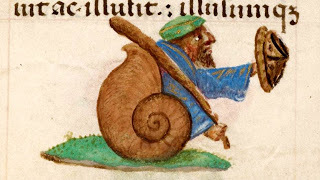 The bearded snail-man, from f 91r in the
Hours of Joanna
the Mad (public domain)
The bearded snail-man, from f 91r in the
Hours of Joanna
the Mad (public domain)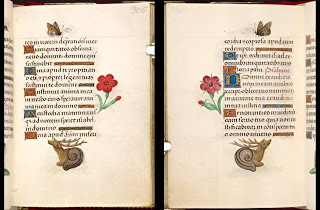 A mirror-image pair of snail-stags from f 305r and f 305v (hence they do not face each other, but I've realigned them to do so here) in the Hours of Joanna the Mad (public domain)
A mirror-image pair of snail-stags from f 305r and f 305v (hence they do not face each other, but I've realigned them to do so here) in the Hours of Joanna the Mad (public domain)An antiphonary is one of the liturgical books intended for use in the liturgical choir, and many medieval examples were elaborately illuminated. One of these is the multi-volume antiphony produced during the 1400s for the Augustinian monastery of San Gaggio (i.e. Pope St Caius) in Florence, Italy, and among its numerous marginalia is a collared snail-dog, with horns or horn-like ears:
[image error] Collared snail-dog from the Antiphony of San Gaggio (public domain)
The Tours MS 0008 manuscript held by the Bibliothèque Municipale in Tours, France, dates from c.1320, originated in Spain, and consists of an illuminated Bible with Latin text, which contains a veritable pantheon of marginalia, including two appearances by snail-goats. In one of these appearances, the horned, beardy-chinned malacomorph in question is defiantly sticking its tongue out at a knight about to shoot it with an arrow (on f 89r); and in the other (on f 327v), it is using its tongue to do something unmentionable to a certain part of a nearby monkey's anatomy!
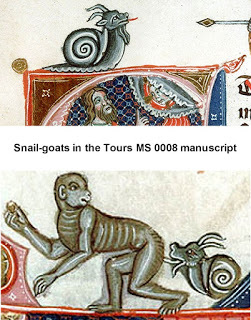 Two snail-goats in the Tours MS 0008 manuscript (public domain)
Two snail-goats in the Tours MS 0008 manuscript (public domain)The Breviary of Renaud de Bar is MS 107 in the collections of the Bibliothèque Municipale in Verdun, France. Dating from the early 1300s, it was commissioned for Renaud de Bar, the bishop of Metz, by his sister, Marguerite, who was the abbess of Abby St Maur. On f 97r is a snail-monk holding a forked club; similarly, on f 107 v, a snail-woman is wielding a forked club and also holding a shield as she confronts a girl wearing nothing but a cap and a mantle that she is holding open towards the malacomorph like some medieval flasher! And on f 160v, yet another forked club is being parried, this time by a man with a shield opposing a rearing snail-goat with long curved horns.
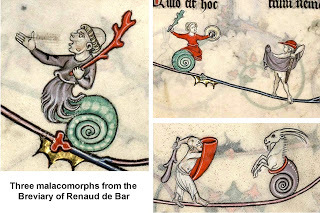 Three scenes featuring marginalia malacomorphs from the Breviary of Renaud de Bar (public domain)
Three scenes featuring marginalia malacomorphs from the Breviary of Renaud de Bar (public domain)Returning once more to snail-cats, and having established that the snail-cat motif is not unique to a single illuminated manuscript, the obvious question now needing to be answered is: what – if anything – does it represent? In medieval lore, each type of animal was invested with certain attributes and thus came to symbolise various specific human emotions and characteristics – love, apathy, piety, hatred, power, deceit, joy, sinfulness, charity, betrayal, loyalty, greed, honesty, lust, virtue, and so forth.
In view of its famous slowness of pace, in Christian symbolism the snail came to epitomise the deadly sin of sloth and laziness. And the cat fared little better in such symbolism, traditionally deemed to personify lasciviousness and cruelty, and to be in league with the forces of darkness. Consequently, it does not bode well for a snail-cat present in a Christian illuminated manuscript to symbolise anything positive or benevolent.
Having said that, however, there is no indication that these feline malacomorphs were intended to signify anything at all. This is because their appearances as marginalia in various folios from such manuscripts seem not to correspond in any way with the main content or text of those particular folios. The same is also true not only for other malacomorphs but also for many marginalia grotesques and drolleries in general.
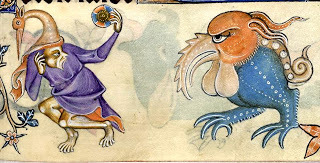 A typically surreal example of marginalia (on f 145r) from the Luttrell Psalter (public domain)
A typically surreal example of marginalia (on f 145r) from the Luttrell Psalter (public domain)If anything, their presence often tends to be more subversive than pertinent, i.e. suggesting that the illuminators have inserted them as sly or playful attempts to mock, deflate, or even act as light, comic relief to the strictly serious, devotional nature of the folios' principal content rather than to instruct or act in any kind of directly relevant, contextual manner.
Moreover, in some cases this phantasmagorical menagerie of marginalia might be nothing more significant than the product of illuminators' attempts to stave off boredom when faced with the exceedingly long and very tedious task of copying or illuminating a major manuscript.
In short, snail-cats and various other bizarre fauna of the folios may simply be medieval doodles, originally executed centuries ago merely as brief, functionless escapes from ennui, but cherished today in their own right as fascinating, captivating fantasies that add charm, surprise, and not a little rebellion to the sternly religious literary abodes in which they linger and lurk, always ready to startle unwary readers with their extraordinary forms and outrageous, humorous behaviour – and long may they continue to do so!
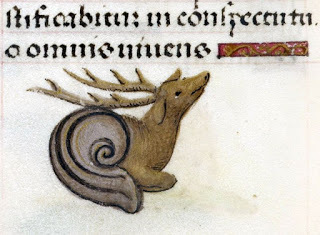 Close-up of the snail-stag from f 305v in the Hours of Joanna the Mad (public domain)
Close-up of the snail-stag from f 305v in the Hours of Joanna the Mad (public domain)
Published on August 14, 2015 11:45
Karl Shuker's Blog
- Karl Shuker's profile
- 45 followers
Karl Shuker isn't a Goodreads Author
(yet),
but they
do have a blog,
so here are some recent posts imported from
their feed.



